
Oven
HB676GB.6B
en
User manual and installation instructions
Register your product on My Siemens and discover exclusive ser-
vices and offers.
siemens-home.bsh-group.com/welcome
The future moving in.
Siemens Home Appliances

en Safety
2
Table of contents
INFORMATION FOR USE
1 Safety....................................................................2
2 Preventing material damage ...............................5
3 Environmental protection and saving en-
ergy .......................................................................5
4 Familiarising yourself with your appliance ........6
5 Operating modes .................................................8
6 Accessories..........................................................9
7 Before using for the first time ...........................11
8 Basic operation ..................................................11
9 Rapid heating .....................................................12
10 Time-setting options..........................................13
11 Dishes .................................................................14
12 Childproof lock...................................................15
13 Sabbath mode ....................................................16
14 HomeConnect ...................................................16
15 Basic settings.....................................................18
16 Cleaning and servicing......................................18
17 Self-cleaning.......................................................20
18 Cleaning assistance...........................................21
19 Appliance door...................................................22
20 Rails ....................................................................24
21 Troubleshooting.................................................25
22 Disposal..............................................................27
23 Customer Service...............................................27
24 Declaration of Conformity .................................28
25 How it works.......................................................28
26 INSTALLATION INSTRUCTIONS .......................33
26.1 General installation instructions....................
...33
1 Safety
Observe the following safety instructions.
1.1 General information
¡ Read this instruction manual carefully.
¡ Keep the instruction manual and the
product information safe for future refer-
ence or for the next owner.
¡ Do not connect the appliance if it has been
damaged in transit.
1.2 Intended use
This appliance is designed only to be built
into kitchen units. Read the special installation
instructions.
Only a licensed professional may connect ap-
pliances without plugs. Damage caused by in-
correct connection is not covered under the
warranty.
Only use this appliance:
¡ To prepare meals and drinks.
¡ In private households and in enclosed
spaces in a domestic environment.
¡ Up to an altitude of max. 4000m above
sea level.
1.3 Restriction on user group
This appliance may be used by children aged
8 or over and by people who have reduced
physical, sensory or mental abilities or inad-
equate experience and/or knowledge,
provided that they are supervised or have
been instructed on how to use the appliance
safely and have understood the resulting
dangers.
Do not let children play with the appliance.
Children must not perform cleaning or user
maintenance unless they are at least 15 years
old and are being supervised.
Keep children under the age of 8 years away
from the appliance and power cable.
1.4 Safe use
Always place accessories in the cooking com-
partment the right way round.
→"Accessories", Page9
WARNING‒Risk of fire!
Combustible objects that are left in the cook-
ing compartment may catch fire.
▶ Never store combustible objects in the
cooking compartment.
▶ If smoke is emitted, the appliance must be
switched off or the plug must be pulled out
and the door must be held closed in order
to stifle any flames.

Safety en
3
Loose food remnants, fat and meat juices
may catch fire.
▶ Before using the appliance, remove the
worst of the food residues and remnants
from the cooking compartment, heating ele-
ments and accessories.
Opening the appliance door creates a
draught. Greaseproof paper may come into
contact with the heating element and catch
fire.
▶ Never place greaseproof paper loosely
over accessories when preheating the ap-
pliance and while cooking.
▶ Always cut greaseproof paper to size and
use a plate or baking tin to hold it down.
WARNING‒Risk of burns!
The appliance and its parts that can be
touched become hot during use.
▶ Caution should be exercised here in order
to avoid touching heating elements.
▶ Young children under 8 years of age must
be kept away from the appliance.
Accessories and cookware get very hot.
▶ Always use oven gloves to remove ac-
cessories or cookware from the cooking
compartment.
When the cooking compartment is hot, any al-
coholic vapours inside may catch fire. The ap-
pliance door may spring open. Hot steam and
jets of flame may escape.
▶ Only use small quantities of drinks with a
high alcohol content in food.
▶ Do not heat spirits (≥ 15% vol.) when undi-
luted (e.g. for marinating or pouring over
food).
▶ Open the appliance door carefully.
WARNING‒Risk of scalding!
The accessible parts of the appliance become
hot during operation.
▶ Never touch these hot parts.
▶ Keep children at a safe distance.
Hot steam may escape when you open the
appliance door. Steam may not be visible, de-
pending on the temperature.
▶ Open the appliance door carefully.
▶ Keep children at a safe distance.
If there is water in the cooking compartment
when it is hot, this may create hot steam.
▶ Never pour water into the cooking compart-
ment when the cooking compartment is
hot.
WARNING‒Risk of injury!
Scratched glass in the appliance door may
develop into a crack.
▶ Do not use any harsh or abrasive cleaners
or sharp metal scrapers to clean the glass
on the oven door, as they may scratch the
surface.
The appliance and its parts that can be
touched may have sharp edges.
▶ Take care when handling and cleaning
them.
▶ If possible, wear protective gloves.
The hinges on the appliance door move when
the door is opened and closed, which could
trap your fingers.
▶ Keep your hands away from the hinges.
Components inside the appliance door may
have sharp edges.
▶ Wear protective gloves.
Alcoholic vapours may catch fire in the hot
cooking compartment, and the appliance
door may spring open and may fall off. The
door panels may shatter and fragment.
→"Preventing material damage", Page5
▶ Only use small quantities of drinks with a
high alcohol content in food.
▶ Do not heat spirits (≥ 15% vol.) when undi-
luted (e.g. for marinating or pouring over
food).
▶ Open the appliance door carefully.
WARNING‒Risk of electric shock!
Incorrect repairs are dangerous.
▶ Repairs to the appliance should only be
carried out by trained specialist staff.
▶ Only use genuine spare parts when repair-
ing the appliance.
▶ If the power cord of this appliance is dam-
aged, it must be replaced by trained spe-
cialist staff.
If the insulation of the power cord is dam-
aged, this is dangerous.
▶ Never let the power cord come into contact
with hot appliance parts or heat sources.
▶ Never let the power cord come into contact
with sharp points or edges.
▶ Never kink, crush or modify the power
cord.
An ingress of moisture can cause an electric
shock.
▶ Do not use steam- or high-pressure clean-
ers to clean the appliance.

en Safety
4
If the appliance or the power cord is dam-
aged, this is dangerous.
▶ Never operate a damaged appliance.
▶ Never pull on the power cord to unplug the
appliance. Always unplug the appliance at
the mains.
▶ If the appliance or the power cord is dam-
aged, immediately unplug the power cord
or switch off the fuse in the fuse box.
▶ Call customer services. →Page27
WARNING‒Danger: Magnetism!
Permanent magnets are used in the control
panel or in the controls. These may affect
electronic implants, e.g. heart pacemakers or
insulin pumps.
▶ Wearers of electronic implants must stay at
least 10 cm away from the control panel.
WARNING‒Risk of suffocation!
Children may put packaging material over
their heads or wrap themselves up in it and
suffocate.
▶ Keep packaging material away from chil-
dren.
▶ Do not let children play with packaging ma-
terial.
Children may breathe in or swallow small
parts, causing them to suffocate.
▶ Keep small parts away from children.
▶ Do not let children play with small parts.
1.5 Halogen bulb
WARNING‒Risk of burns!
The bulbs in the cooking compartment get
very hot. There is still a risk of burning for
some time after they have been switched off.
▶ Do not touch the glass cover.
▶ Avoid contact with your skin when cleaning.
WARNING‒Risk of electric shock!
When changing the bulb, the bulb socket con-
tacts are live.
▶ Before replacing the bulb, ensure that the
appliance is switched off in order to pre-
vent a potential electric shock.
▶ Also unplug the appliance from the mains
or switch off the circuit breaker in the fuse
box.
1.6 Cleaning function
WARNING‒Risk of fire!
Loose food remnants, fat and meat juices
may catch fire when the cleaning function is in
progress.
▶ Before starting the cleaning function, al-
ways remove the worst of the food residues
and remnants from the cooking compart-
ment and accessories.
The outside of the appliance gets very hot
when the cleaning function is in progress.
▶ Never hang combustible objects, e.g. tea
towels, on the door handle.
▶ Leave the front of the appliance clear.
▶ Keep children at a safe distance.
If the door seal is damaged, a large amount
of heat is generated around the door.
▶ Do not scrub or remove the seal.
▶ Never operate the appliance if the seal is
damaged or missing.
WARNING‒Risk of serious harm to
health!
The appliance gets very hot when the clean-
ing function is in progress. The non-stick coat-
ing on baking trays and tins is destroyed and
noxious gases are released.
▶ Never clean non-stick baking trays or bak-
ing tins using the cleaning function.
▶ Only clean enamelled accessories at the
same time.
WARNING‒Risk of harm to health!
The cleaning function heats up the cooking
compartment to a very high temperature so
that food left over from roasting, grilling and
baking will burn off. This process releases va-
pours, which can irritate mucous membranes.
▶ Keep the kitchen well ventilated while the
cleaning function is running.
▶ Do not remain in the room for long periods.
▶ Keep children and pets away.
WARNING‒Risk of burns!
The cooking compartment gets very hot when
the cleaning function is in progress.
▶ Never open the appliance door.
▶ Allow the appliance to cool down.
▶ Keep children at a safe distance.

Preventing material damage en
5
The outside of the appliance gets very hot
when the cleaning function is in progress.
▶ Never touch the appliance door.
▶ Allow the appliance to cool down.
▶ Keep children at a safe distance.
2 Preventing material damage
2.1 General
ATTENTION!
Alcoholic vapours may catch fire in the hot cooking
compartment and cause permanent damage to the ap-
pliance. The appliance door may spring open due to
an explosion and it may fall off. The door panels may
shatter and fragment. Due to the resulting negative
pressure, the cooking compartment may become con-
siderably deformed inwards.
▶ Do not heat spirits (≥ 15% vol.) when undiluted (e.g.
for marinating or pouring over food).
If there is water on the cooking compartment floor
when operating the appliance at temperatures above
120°C, this will damage the enamel.
▶ Do not use the appliance if there is water on the
cooking compartment floor.
▶ Wipe away any water on the cooking compartment
floor before operation.
Objects on the cooking compartment floor at over
50°C will cause heat to build up. The baking and
roasting times will no longer be correct and the enamel
will be damaged.
▶ Do not place any accessories, greaseproof paper or
foil of any kind on the cooking compartment floor.
▶ Only place cookware on the cooking compartment
floor if a temperature above 50°C has been set.
When the cooking compartment is hot, any water in-
side it will create steam. The change in temperature
may cause damage.
▶ Never pour water into the cooking compartment
when it is still hot.
▶ Never place cookware containing water on the
cooking compartment floor.
The prolonged presence of moisture in the cooking
compartment leads to corrosion.
▶ Allow the cooking compartment to dry after use.
▶ Do not keep moist food in the cooking compartment
for a long time with the door closed.
▶ Do not store food in the cooking compartment.
Leaving the appliance to cool down with the door open
will damage the front of neighbouring kitchen units over
time.
▶ Always allow the cooking compartment to cool
down with the door closed after cooking at high
temperatures.
▶ Take care not to trap anything in the appliance
door.
▶ Only leave the cooking compartment to dry with the
door open if a lot of moisture was produced during
operation.
Fruit juice dripping from the baking tray leaves stains
that cannot be removed.
▶ When baking very juicy fruit flans, do not pack too
much on the baking tray.
▶ If possible, use the deeper universal pan.
Using oven cleaner in a hot cooking compartment
damages the enamel.
▶ Never use oven cleaner in the cooking compartment
when it is still warm.
▶ Remove all food remnants from the cooking com-
partment and the appliance door before you next
heat up the appliance.
If the seal is very dirty, the appliance door will no
longer close properly during operation. This may dam-
age the front of adjacent kitchen units.
▶ Keep the seal clean at all times.
▶ Never operate the appliance if the seal is damaged
or missing.
Sitting or placing objects on the appliance door may
damage it.
▶ Do not place, hang or support objects on the appli-
ance door.
▶ Do not place cookware or accessories on the appli-
ance door.
With certain models, accessories may scratch the door
pane when closing the appliance door.
▶ Always push accessories fully into the cooking com-
partment.
3 Environmental protection and saving energy
3.1 Disposing of packaging
The packaging materials are environmentally compat-
ible and can be recycled.
▶
Sort the individual components by type and dispose
of them separately.
3.2 Saving energy
If you follow these instructions, your appliance will use
less power.
Only preheat the appliance if the recipe or the recom-
mended settings tell you to do so.
¡
Not preheating the appliance can reduce the en-
ergy used by up to 20%.
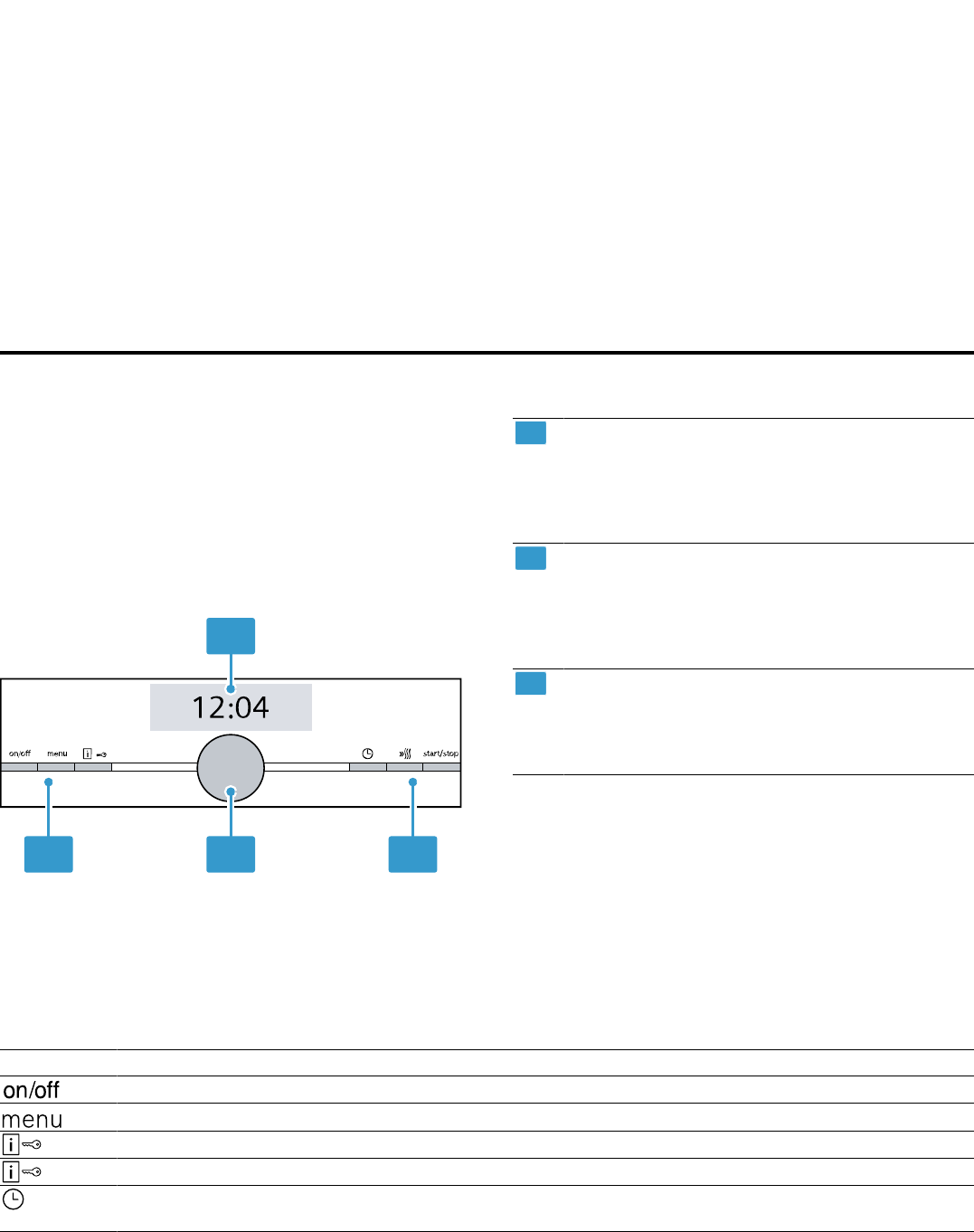
en Familiarising yourself with your appliance
6
Use dark-coloured, black-coated or enamelled baking
tins.
¡
These types of baking tin absorb the heat particu-
larly well.
Open the appliance door as little as possible during
operation.
¡
This maintains the temperature in the cooking com-
partment and eliminates the need for the appliance
to reheat.
When baking multiple dishes, do so in succession or
in parallel.
¡
The cooking compartment is heated after baking
the first dish. This reduces the baking time for the
second cake.
If the cooking time is relatively long, you can switch
the appliance off 10minutes before the cooking time
ends.
¡
There will be enough residual heat to finish cooking
the dish.
Remove any accessories that are not being used from
the cooking compartment.
¡
Accessories that are not being used do not need to
be heated.
Allow frozen food to defrost before cooking.
¡
This saves the energy that would otherwise be re-
quired to defrost it.
Note:
The appliance requires:
¡ A maximum of2W in networked standby mode
¡ A maximum of 1W when the appliance is not con-
nected to the network, with the display switched on
¡ A maximum of 0.5W when the appliance is not con-
nected to the network, with the display switched off
4 Familiarising yourself with your appliance
4.1 Control panel
You can use the control panel to configure all functions
of your appliance and to obtain information about the
operating status.
Note:On certain models, specific details such as col-
our and shape may differ from those pictured.
1 2
3
1
1
Buttons
The buttons on the left- and right-hand side of
the control panel have a pressure point. Press
a button to execute its function. On appliances
without a stainless steel front, the buttons are
also touch fields.
2
Rotary selector
You can turn the rotary selector without limits
clockwise or anti-clockwise.
Touch fields are touch-sensitive surfaces. To
select a function, simply press lightly on the rel-
evant field.
3
Touch display
You can see the current selection options in the
touch displays. To select a function, press dir-
ectly on the corresponding field. The text fields
change depending on the selection.
4.2 Buttons
Use the buttons on the left- and right-hand side of the control panel to switch your device or the operating mode on
and off.
Button Function Use
On/off Switch the appliance on or off.
Menu Open the operating mode menu
Information Display notifications Activate and deactivate the childproof lock
Childproof lock Activate and deactivate the childproof lock
Time-setting options Press briefly: Start or pause operation.
Press and hold for approx. threeseconds: Cancel operation.
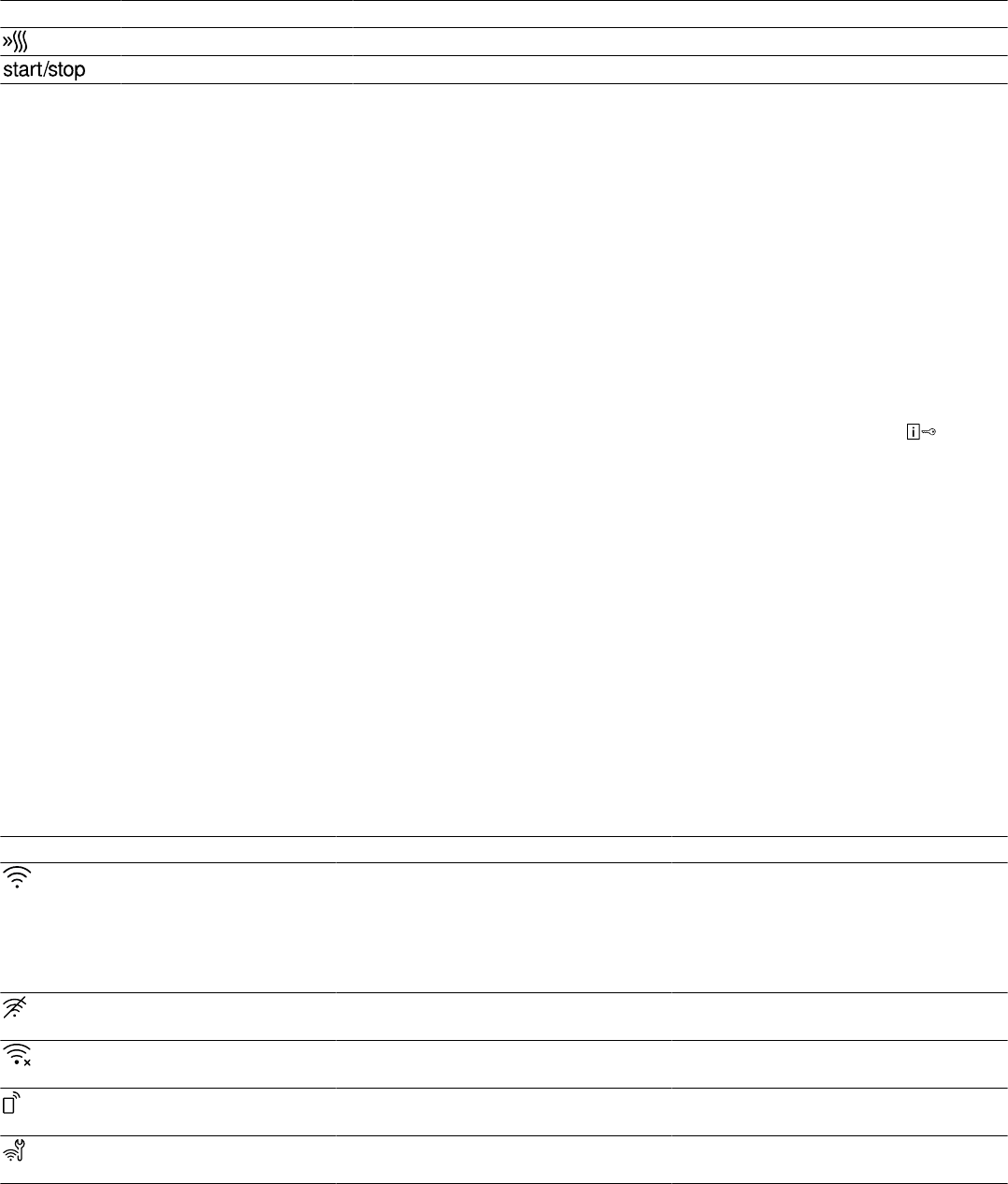
Familiarising yourself with your appliance en
7
Button Function Use
Rapid heat-up Switch rapid heat-up on and off
Start/stop Start, pause or cancel the operation
4.3 Rotary selector
Use the rotary selector to change the setting values
that are shown in the display.
If you have reached the minimum or maximum value
for setting values, e.g. the temperature, this value re-
mains in the display. If required, use the rotary selector
to turn the value back again.
For lists, e.g. the types of heating, the first value starts
again after the last value.
4.4 Display
The display shows the current setting values.
The value that you can change in the display is high-
lighted in colour.
Status bar
The status bar is at the top of the display.
The time and set time functions are shown in the status
bar.
Progress line
The line is shown in the display below the highlighted
value.
The progress line shows you how much the appliance
has already heated up or how much time has elapsed.
The line is filled from left to right.
Countdown
You can view the countdown time or the cooking time
for the previous operation in the top right in the status
bar.
If you have set a cooking time and the cooking time is
deleted, the countdown time takes over from the time
that has already elapsed from the cooking time. You
can therefore always check how long the operation has
already been running.
Temperature display
The heating-up control and the residual heat indicator
show you the temperature in the cooking compartment.
Due to thermal inertia, the temperature that is displayed
may differ slightly from the actual temperature inside
the cooking compartment. You can use the
button
to check the current temperature.
¡ Heating-up control
After the operation starts, the heating-up indicator
displays the rising temperature in the cooking com-
partment. When you are preheating the appliance,
the optimal time to place your food in the cooking
compartment is as soon as all the bars are filled.
For set levels, e.g. for grill settings, the heating-up
indicator is not displayed.
¡ Residual heat indicator
When the appliance is switched off, the display
shows the residual heat in the cooking compart-
ment. The residual heat indicator goes out at ap-
prox. 60°C.
Symbols
Different symbols may appear on the display.
Symbol Name Use
HomeConnect ¡ Home network and HomeCon-
nect server connected
¡ The number of lines shows the
signal strength of the home net-
work
→"HomeConnect ", Page16
Home network Home network not connected
→"HomeConnect ", Page16
HomeConnect server HomeConnect server not connected
→"HomeConnect ", Page16
Remote start Remote start activated
→"HomeConnect ", Page16
Remote diagnostics Remote diagnostics activated
→"HomeConnect ", Page16
4.5 Cooking compartment
The functions in the cooking compartment make your
appliance easier to use.
Shelf supports
The rails in the cooking compartment enable you to
place accessories at different heights.
→"Accessories", Page9
Your appliance has five shelf positions. The shelf posi-
tions are numbered from bottom to top.

en Operating modes
8
You can remove the rails, e.g. for cleaning.
→"Rails", Page24
Lighting
One or more oven lights illuminate the cooking com-
partment.
When you open the appliance door, the light in the
cooking compartment switches on. If the appliance
door remains open for longer than 15minutes, the light
switches off again.
For most operating modes, the lighting is switched on
during operation. The lighting switches off again when
the operation ends.
Cooling fan
The cooling fan switches on and off depending on the
appliance's temperature. The hot air escapes above
the door.
ATTENTION!
Do not cover the ventilation slot above the appliance
door. The appliance overheats.
▶ Ensure that the ventilation slots are unobstructed.
To ensure that the appliance cools down more quickly
after operation, the cooling fan continues to run for a
certain period afterwards.
Appliance door
If you open the appliance door during operation, the
operation stops. When you close the appliance door,
the operation continues automatically.
5 Operating modes
This is where you can find an overview of your appli-
ance's operating modes and main functions.
Press
to open the menu.
Operating
mode
Use
Types of
heating
Select finely tuned types of heating for
the optimal preparation of your food.
→"Types of heating", Page8
Meals Use programmed, recommended set-
tings for various meals.
→"Dishes", Page14
Operating
mode
Use
Self-clean-
ing
The self-cleaning function cleans your
oven automatically.
→"Self-cleaning", Page20
Basic set-
tings
Adjust the basic settings. Basic settings
→Page18
HomeCon-
nect
Connect the oven to a mobile end
device and remotely control it.
→"HomeConnect ", Page16
5.1 Types of heating
To ensure that you always use the right type of heating
to cook your food, we explain the differences and ap-
plications below.
The symbols for each type of heating help you to re-
member them.
When you select a type of heating, the appliance sug-
gests a suitable temperature or setting. You can use
these values or change them within the specified
range.
For temperature settings above 275°C and grill set-
ting3, the appliance reduces the temperature to ap-
prox. 275°C or grill setting1 after approx. 40minutes.
Symbol Type of heating Temperature
range
What it's used for and how it works
Possible additional options
4Dhot air 30–275°C Bake and roast on one or more levels.
The fan distributes the heat from the ring-shaped heating element
in the back wall evenly around the cooking compartment.
Top/bottom heating 30–300°C Traditionally bake or roast on one level. This type of heating is
ideal for cakes with moist toppings.
The heat is emitted evenly from above and below.
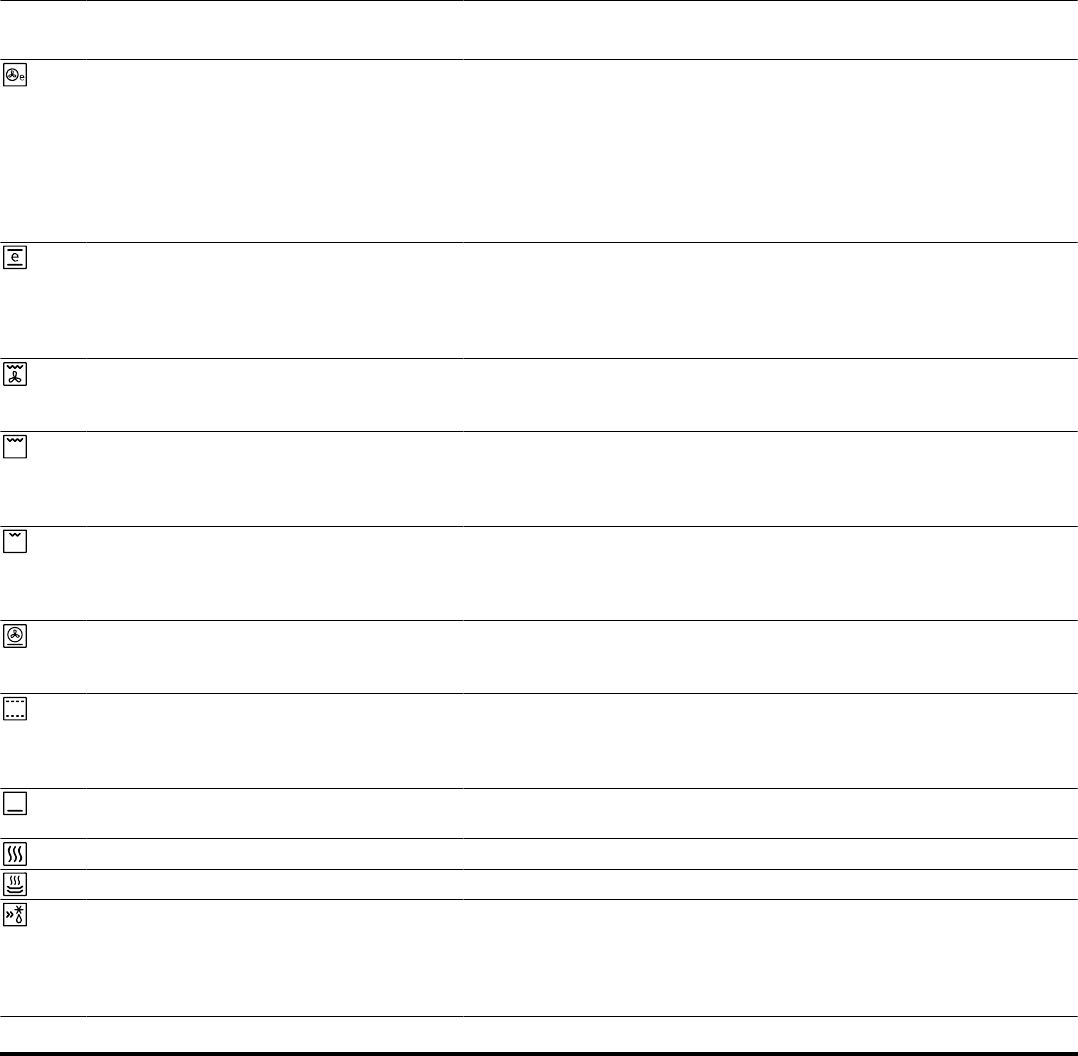
Accessories en
9
Symbol Type of heating Temperature
range
What it's used for and how it works
Possible additional options
Hot air eco 30–275°C Cook selected dishes gently on one level without preheating.
The fan distributes the heat from the ring-shaped heating element
in the back wall evenly around the cooking compartment. The
food is cooked in phases using residual heat.
This type of heating is most effective between 125 and 275°C.
Always keep the appliance door closed when cooking.
This type of heating is used to determine the energy consump-
tion in air recirculation mode and the energy efficiency class.
Top/bottom heating
eco
30–300°C Gently cook selected dishes.
Heat is emitted from above and below.
This heating function is most effective between 150 and 250°C.
This type of heating is used to measure the energy consumption
in the conventional mode.
Circulated air grilling 30–300°C Roast poultry, whole fish or larger pieces of meat.
The grill element and the fan switch on and off alternately. The
fan circulates the hot air around the food.
Grill, large area Grill settings:
1 = low
2 = medium
3 = high
Grill flat items such as steak and sausages, or make toast. Grat-
inate food.
The entire area below the grill element becomes hot.
Grill, small area Grill settings:
1 = low
2 = medium
3 = high
Grill small quantities, such as steak, sausages or toast. Gratinate
small quantities of food.
The central area below the grill element becomes hot.
Pizza setting 30–275°C Cook pizza or dishes that require a lot of heat from below.
The bottom heating element and the ring-shaped heating ele-
ment in the back wall heat the cooking compartment.
Slow cooking 70–120°C Slowly and gently cook seared, tender pieces of meat in un-
covered cookware.
The heat is emitted evenly from above and below at a low tem-
perature.
Bottom heating 30–250°C Final baking or cooking food in a bain marie.
Heat is emitted from below.
Keeping food warm 60–100°C Keep cooked food warm.
Plate warming 30–70°C Plate warming.
CoolStart function 30–275°C For quickly preparing frozen products at position3. The temper-
ature depends on the manufacturer's instructions. Use the
highest temperature specified on the packaging.
The cooking time is as specified, or shorter.
Preheating is not useful.
6 Accessories
Use original accessories. These have been made espe-
cially for your appliance.
Note:Accessories may become deformed if they get
hot. Deformation has no effect on function. As the ac-
cessory cools down, it will regain its original shape.
The accessories supplied may differ depending on the
appliance model.
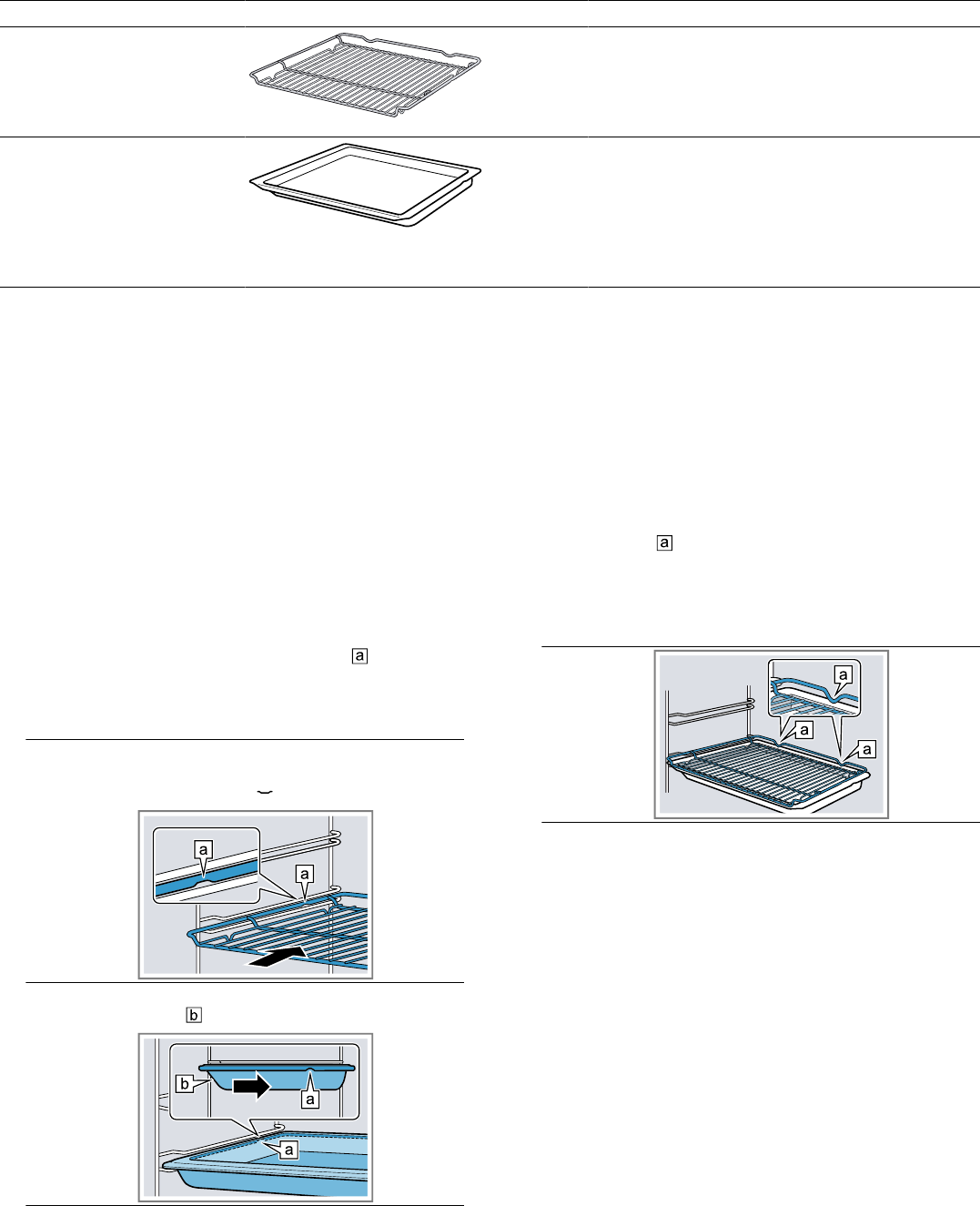
en Accessories
10
Accessories Use
Wire rack ¡ Cake tins
¡ Ovenproof dishes
¡ Cookware
¡ Meat, e.g. roasting joints or steak
¡ Frozen meals
Universal pan ¡ Moist cakes
¡ Baked items
¡ Bread
¡ Large roasts
¡ Frozen meals
¡ Catch dripping liquids, e.g. fat when
grilling food on the wire rack.
6.1 Locking function
The locking function prevents the accessories from tilt-
ing when they are pulled out.
You can pull out the accessories approximately halfway
without them tipping. The accessories must be inserted
into the cooking compartment correctly for the tilt pro-
tection to work properly.
6.2 Sliding accessories into the cooking
compartment
Always slide the accessory into the cooking compart-
ment the right way round. This is the only way to en-
sure that accessories can be pulled out approximately
halfway without tipping.
1.
Turn the accessories so that the notch
is at the
rear and is facing downwards.
2.
Insert the accessory between the two guide rods for
a shelf position.
Wire rack Insert the wire rack with the open
side facing the appliance door and
the curved lip facing downwards.
Baking tray
E.g. univer-
sal pan or
baking tray
Slide the tray in with the sloping
edge towards the appliance door.
3.
Push the accessory all the way in, making sure that
it does not touch the appliance door.
Note:Take any accessories that you will not be using
out of the cooking compartment while the appliance is
in operation.
Combining accessories
You can combine the wire rack with the universal pan
to catch any liquid that drips down.
1.
Place the wire rack on the universal pan so that
both spacers
are on the rear edge of the univer-
sal pan.
2.
Insert the universal pan between the two guide rods
for a shelf position. In so doing, the wire rack is on
top of the upper guide rod.
Wire rack
on univer-
sal pan
6.3 Other accessories
You can purchase other accessories from our after-
sales service, specialist retailers or online.
You will find a comprehensive range of products for
your appliance in our brochures and online:
siemens-home.bsh-group.com
Accessories vary from one appliance to another. When
purchasing accessories, always quote the exact
product number (E no.) of your appliance.
You can find out which accessories are available for
your appliance in our online shop or from our after-
sales service.
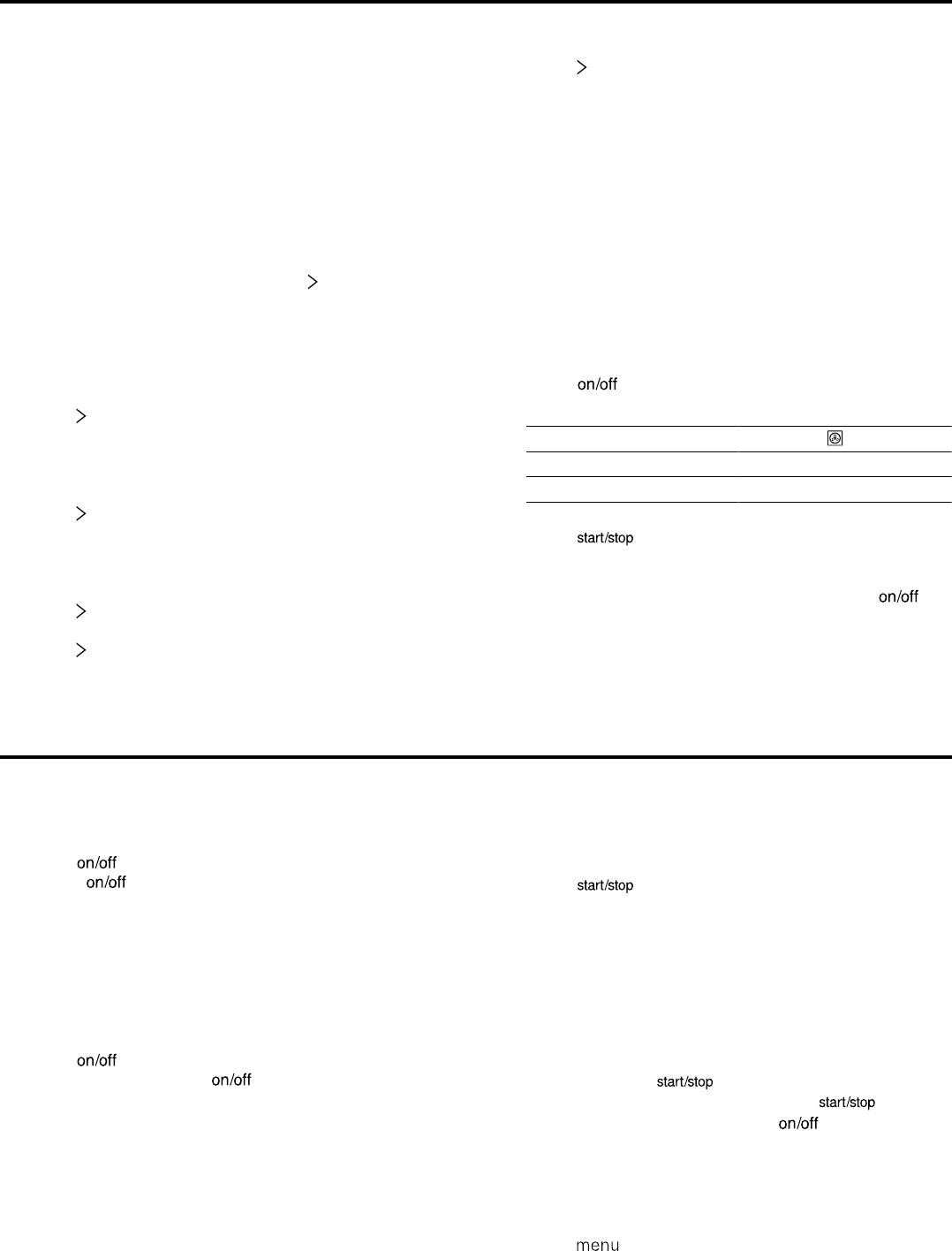
Before using for the first time en
11
7 Before using for the first time
Configure the settings for initial start-up. Clean the ap-
pliance and accessories.
7.1 Carrying out the initial configuration
When the appliance is connected to the electricity sup-
ply for the first time or following a lengthy power cut,
you must configure the settings before you can use it. It
may take a few seconds for the settings to appear on
the display.
Note:You can also enter the settings using the Home
Connect assistant. In this case, press to go to the
last point in the initial configuration. If your appliance is
connected, follow the instructions in the app.
Setting the language
1.
Use the rotary selector to select the required lan-
guage.
2.
Press
.
a The next setting appears.
Setting the time
1.
Turn the rotary selector to set the current time.
2.
Press
.
a The next setting appears.
Setting the date
1.
Use the rotary selector to set the current day.
2.
Press
.
3.
Use the rotary selector to set the current month.
4.
Press .
5.
Use the rotary selector to set the current year.
6.
Press
.
a A notification appears on the display confirming that
the initial configuration is complete.
7.2 Cleaning the appliance before using it
for the first time
Before using the appliance to cook food for the first
time, you must clean the cooking compartment and ac-
cessories.
1.
Remove the product information and the accessor-
ies from the cooking compartment. Remove any
leftover packaging, such as polystyrene pellets, and
any adhesive tape either in or on the appliance.
2.
Wipe the smooth surfaces in the cooking compart-
ment with a soft, damp cloth.
3.
Press
to switch the appliance on.
4.
Apply the following settings:
Type of heating 4Dhot air
Temperature Maximum
Cooking time 1hour
→"Basic operation", Page11
5.
Press
to start the operation.
‒ Ventilate the kitchen while the appliance is heat-
ing.
6.
When the cooking time has elapsed, press to
switch the appliance off.
7.
Once the appliance has cooled down, clean the
smooth surfaces in the cooking compartment with a
detergent solution and a dish cloth.
8.
Clean the accessories thoroughly using a detergent
solution and a dish cloth or soft brush.
8 Basic operation
8.1 Switching on the appliance
▶
Press
to switch the appliance on.
‒ The button lights up blue.
a The Siemens logo appears in the display. A type of
heating and a temperature are then displayed.
8.2 Switching off the appliance
Switch your appliance off when you are not using it.
The appliance will switch itself off automatically if it is
not used for a certain period of time.
▶
Press to switch the appliance off.
‒ The light above the button goes out.
a The appliance switches off. Any functions currently
in progress are cancelled.
a The time or residual heat indicator appears in the
display.
8.3 Starting operation
You must start each cooking operation.
▶
Press to start the operation.
a The settings, the run time and the heat-up line ap-
pear on the display.
8.4 Pausing or cancelling operation
You can briefly pause the operation and then continue.
If you cancel the operation completely, the settings are
reset.
1.
To pause the operation briefly:
‒ Briefly press
.
‒ To continue the operation, press
.
2.
To cancel the operation, press
.
a The operation stops and all of the settings are reset.
8.5 Setting an operating mode
Requirement:The appliance must be switched on.
1.
Press
.
The operating modes menu opens.
2.
Press the operating mode that you require.

en Rapid heating
12
Various options are available depending on the op-
erating mode.
3.
The selection can be changed using the rotary se-
lector.
Change any further settings depending on the selec-
tion.
4.
Press
to start.
8.6 Setting the type of heating and the
temperature
When you switch on the appliance, the types of heating
operating mode is set automatically.
1.
Turn the rotary selector to select the required type
of heating.
2.
Press the temperature.
3.
Use the rotary selector to set the temperature.
4.
Press
to start the operation.
a The appliance starts heating.
a The set type of heating, temperature and cooking
time/appliance run time are shown in the display.
5.
When the food is ready, press
to switch the
appliance off.
Tip:The most suitable type of heating for your food
can be found in the type of heating description.
Note:You can also set a cooking time and an opera-
tion end time on the appliance.
→"Time-setting options", Page13
Changing the type of heating
When you change the type of heating, the other set-
tings are also reset.
1.
Press
to pause operation.
2.
Press the type of heating.
3.
Turn the rotary selector to select the required type
of heating.
a The corresponding recommended temperature ap-
pears on the display.
Changing the temperature
Once the operation has started, you can change the
temperature directly.
▶
Use the rotary selector to change the temperature.
a The temperature is applied immediately.
8.7 Displaying information
In most cases, you can call up information about the
function that you have just started. The appliance auto-
matically displays certain information, e.g. to ask you to
do/confirm something or to issue a warning.
▶
Press
.
a When available, information is displayed for a few
seconds.
9 Rapid heating
To save time, you can shorten the preheating time for
set temperatures of 100°C and higher.
You can use rapid heating for this type of heating:
¡ 4Dhot air
¡ Top/bottom heating
9.1 Setting rapid heating
To ensure an even cooking result, do not place the
food in the cooking compartment until rapid heating
has come to an end.
Note:Do not set a cooking time until rapid heating has
come to an end.
1.
Set a suitable type of heating and a temperature of
at least 100°C.
2.
Press
.
a The symbol appears on the left of the display
next to the temperature.
a The progress line begins to fill up.
3.
a When rapid heating has come to an end, a signal
tone sounds. The
symbol disappears from the
display.
4.
Place the food in the cooking compartment.
Cancelling rapid heating
▶
Press
.
a The symbol disappears from the display.
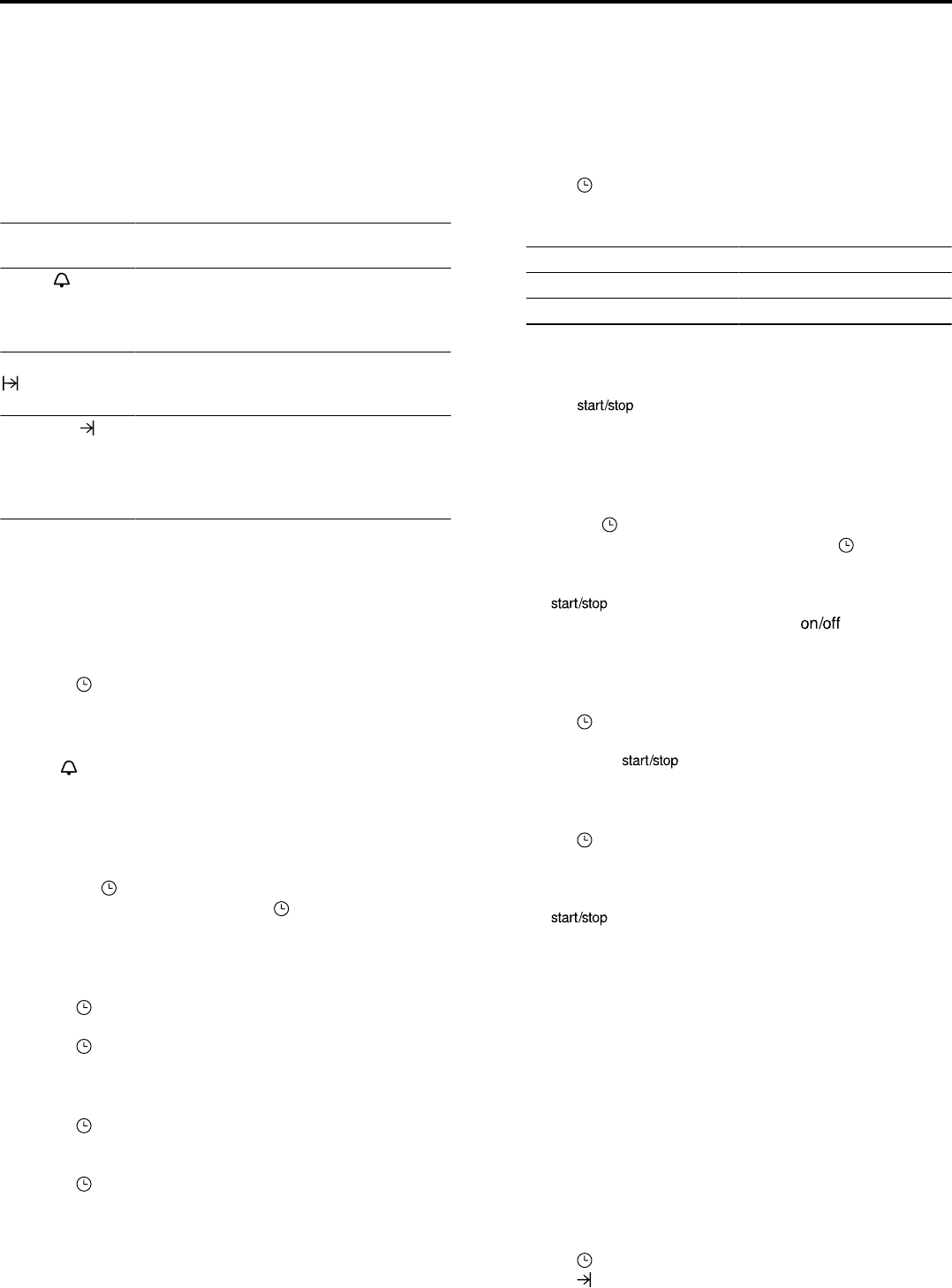
Time-setting options en
13
10 Time-setting options
Your appliance has different time-setting options, with
which you can control its operation.
10.1 Overview of the time-setting options
You can set a cooking time and an operation end time
on the appliance. The timer runs independently of the
appliance during the operation.
Time-setting
option
Use
Timer You can set the timer to run inde-
pendently of the appliance during op-
eration. It does not affect the appli-
ance.
Cooking time
If you set a cooking time, the appli-
ance will stop heating automatically
once this time has elapsed.
End time Along with the cooking time (dura-
tion), you can set the time at which
you want cooking to end. The appli-
ance starts up automatically so that it
finishes cooking at the required time.
10.2 Setting the timer
The timer runs independently during the operation. The
timer can be set when the appliance is switched on or
off, up to 24 hours. The timer has its own audible sig-
nal so that you can tell whether it is the timer or a
cooking time that has elapsed.
1.
Press
.
a The field for the timer opens.
2.
Use the rotary selector to set the timer duration.
a The timer starts automatically after a few seconds.
a The
symbol and the time counting down are dis-
played on the left in the status bar.
a The timer counts down.
a When the timer duration has elapsed, a note ap-
pears on the display and an audible signal sounds.
3.
Once the timer duration has elapsed:
‒ Press
to silence the audible signal manually.
‒ To set another timer, press
and use the rotary
selector to set the duration.
Changing the timer
You can change the timer duration at any time.
1.
Press .
2.
Use the rotary selector to change the timer duration.
3.
Press to confirm.
Cancelling the timer
You can cancel the timer duration at any time.
1.
Press
.
2.
Use the rotary selector to reset the timer duration to
zero.
3.
Press to confirm.
10.3 Setting the cooking time
You can set a cooking time for operation of up to 23
hours 59 minutes.
Requirement:The type of heating and a temperature
or setting have been set.
1.
Press
.
a The time-setting options menu opens.
2.
Use the rotary selector to set the cooking time.
Rotation direction Default value
Left 10 minutes
Right 30 minutes
The cooking time can be set in one-minute incre-
ments up to one hour, and then in five-minute incre-
ments. The end time is calculated automatically.
3.
Press
to start the operation.
a The appliance starts to heat and the time starts to
count down.
a Once the cooking time has elapsed, an audible sig-
nal sounds. "Finished" appears in the status bar.
4.
Once the cooking time has elapsed:
‒ Press to silence the audible signal manually.
‒ To set another cooking time, press
and use
the rotary selector to set the cooking time.
‒ To continue without setting a cooking time, press
.
‒ When the food is ready, press to switch the
appliance off.
Changing the cooking time
You can change the cooking time at any time.
1.
Press
.
2.
Use the rotary selector to change the cooking time.
3.
Then press twice.
Cancelling the cooking time
You can cancel the cooking operation time at any time.
1.
Press .
2.
Use the rotary selector to reset the cooking time to
zero.
3.
‒ To continue without setting a cooking time, press
.
The type of heating and temperature settings are
shown in the display.
10.4 Setting the end time
You can delay the time at which cooking is due to fin-
ish by up to 23 hours and 59 minutes.
Notes
¡ In order to achieve good cooking results, do not
delay the end time once the appliance is operating.
¡ Food will spoil if you leave it in the cooking com-
partment for too long.
Requirements
¡ The type of heating and a temperature or setting
have been set.
¡ A cooking time is set.
1.
Press .
2.
Press .
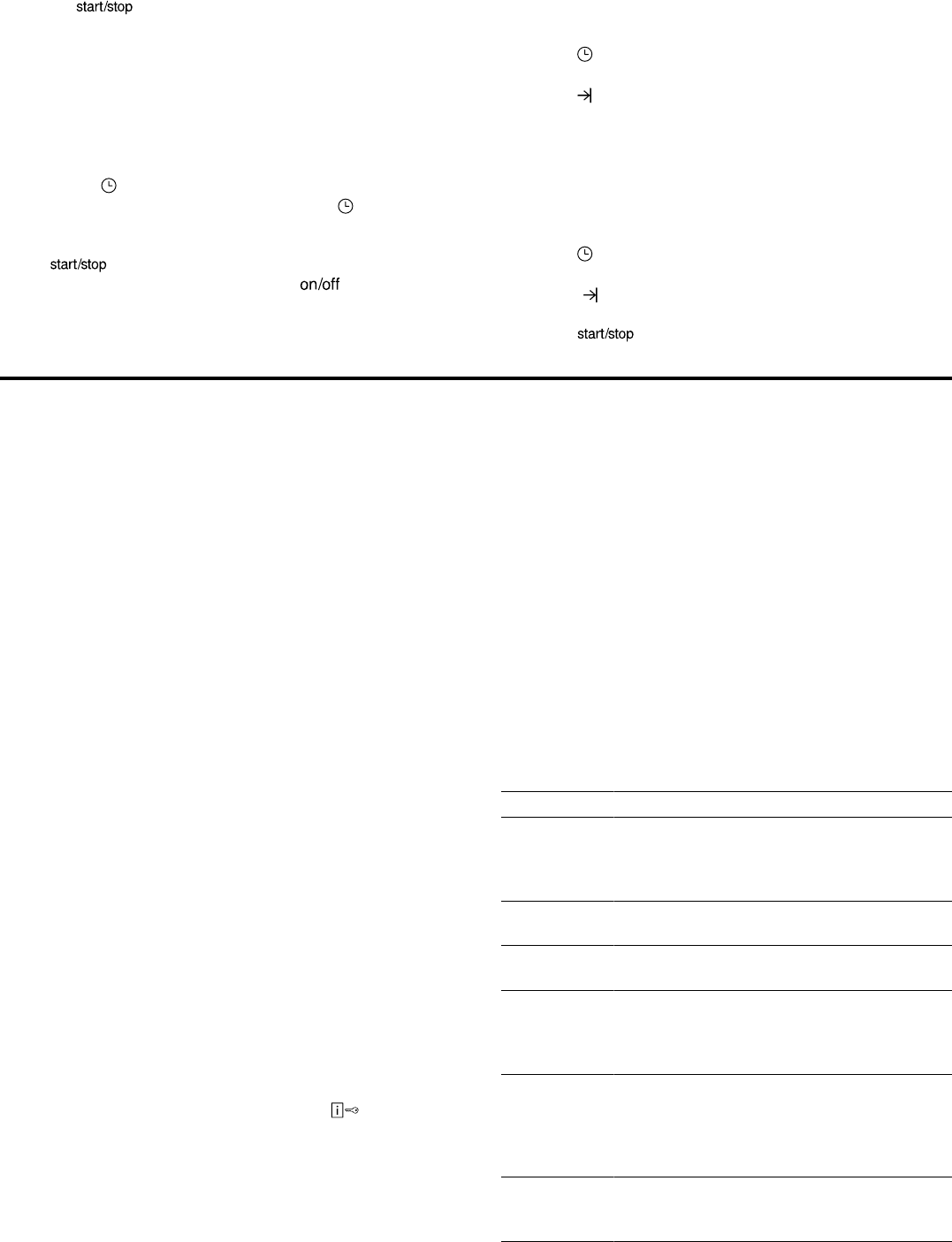
en Dishes
14
3.
To set a later end time, turn the rotary selector.
4.
Press
to start the operation.
a The status bar shows a notification when the opera-
tion starts. The appliance is in standby mode.
a Once the start time has been reached, the appli-
ance starts heating and the cooking time starts
counting down in the status bar.
a Once the cooking time has elapsed, an audible sig-
nal sounds. A notification appears in the status bar.
5.
Once the cooking time has elapsed:
‒ Press to silence the audible signal manually.
‒ To set another cooking time, press
and use
the rotary selector to set the cooking time.
‒ To continue without setting a cooking time, press
.
‒ When the food is ready, press to switch the
appliance off.
Cancelling the end time
The set end time can only be changed when the oven
is in standby mode.
1.
Press
.
a The time-setting options menu opens.
2.
Press
.
3.
Use the rotary selector to reset the end time to zero.
a The appliance starts to heat and the time starts to
count down.
Changing the end time
The set end time can only be changed when the oven
is in standby mode
1.
Press
.
a The time-setting options menu opens.
2.
Press "
end".
3.
Turn the rotary selector to change the end time.
4.
Press to resume operation.
11 Dishes
The "Dishes" operating mode helps you to use your ap-
pliance to prepare different meals by selecting the op-
timum settings automatically.
11.1 Cookware
The cooking result depends on the composition of the
meat and the size of cookware.
You should therefore use heat-resistant cookware that
is suitable for temperatures up to 300°C. Glass or
glass ceramic cookware is best. The joint should cover
approx. two thirds of the cookware base.
Cookware made from the following material is not
suitable:
¡ Bright, shiny aluminium
¡ Unglazed clay
¡ Plastic or plastic handles
11.2 Settings for the dishes
To make the dishes perfectly, the appliance uses differ-
ent settings.
Note:The cooking result depends on the quality and
composition of the food. Use fresh and, ideally, chilled
food. Use frozen food straight from the freezer.
Tips and information about the settings
If you set a dish, the display shows relevant information
for this dish, e.g.:
¡ Suitable shelf position
¡ Suitable accessory or cookware
¡ Added liquid
¡ Time for turning or stirring
When this time is reached, a signal sounds.
To call up the information, press "Tip" or
. Some
notes are displayed automatically.
Programmes
The ideal type of heating, temperature and cooking
time are preset for programmes.
In order to obtain an optimal cooking result, you must
also set the weight. Unless otherwise indicated, set the
total weight for your dish. You can set the weight only
in the intended range.
Recommended settings
For the recommended settings, the optimum type of
heating is preset. The display shows the type of heat-
ing.
You can adjust the preset temperature and the cooking
time.
11.3 Overview of the dishes
You can find out which individual dishes are available
to you on the appliance when you call up the operating
mode.
The dishes are sorted by categories and food.
Category Foods
Cakes Cakes in tins
Cakes on a baking tray
Small baked items
Biscuits
Bread,
bread rolls
Bread
Bread rolls
Pizza, sa-
voury cakes
Pizza
Savoury cakes, quiche
Bakes,
soufflés
Fresh lasagne
Soufflés in individual molds
Fruit crumble
Yorkshire pudding
Frozen
products
Pizza
Bread rolls
Bakes
Potato products
Poultry, fish
Poultry Chicken
Duck, goose
Turkey

Childproof lock en
15
Category Foods
Meat Pork
Beef
Lamb
Meat dishes
Fish Fish
Vegetables Stew with vegetables
Browning vegetables
Baked potatoes, whole
11.4 Adjusting the dish
Note:Once it has started, you can no longer change or
interrupt the dish or the settings.
Requirement:To start the operation, the cooking com-
partment must be cooled down.
1.
Press
.
2.
In the operating modes menu, select "Dishes".
a The first dish is suggested.
3.
Use the rotary selector to select the required cat-
egory.
4.
Press "Continue".
5.
Use the rotary selector to select the required food.
6.
Press "Continue".
7.
Use the rotary selector to set the required dish.
8.
Press "Continue".
9.
Adjust the settings if required.
‒ For some dishes, you can change the temperat-
ure, the cooking time or the end time by pressing
"Adjust".
‒ For some dishes, you can set the weight directly
using the rotary selector.
10.
For information about the accessory and shelf posi-
tion, press "Tip".
11.
Press
to start the operation.
a The appliance starts to heat and the time starts to
count down. The heating line does not appear.
a Once the dish is ready, a signal sounds. The appli-
ance stops heating.
12.
Once the cooking time has elapsed:
‒ Press to silence the audible signal manu-
ally.
‒ For some dishes, you can extend the cooking
time if necessary.
→"Adding extra cooking time", Page15
‒ When the dish is ready, press
to switch the
appliance off.
Adding extra cooking time
For some dishes, the appliance allows you to extend
the cooking time once the set cooking time has
elapsed. You can do this as often as required.
1.
If you do not want to extend the cooking time, press
"End" and then to switch the appliance off.
2.
To extend the cooking time, press "Continue cook-
ing".
a A cooking time appears on the display.
3.
If necessary, use the rotary selector to change the
cooking time.
4.
Press
to start the operation.
a The appliance starts to heat and the time starts to
count down.
a Once the cooking time has elapsed, an audible sig-
nal sounds. The appliance stops heating. The noti-
fication for extending the cooking time appears
again.
5.
Once the cooking time has elapsed:
‒ Press to silence the audible signal manu-
ally.
‒ If you want to extend the cooking time again,
press "Continue cooking".
‒ When the dish is ready, press "End" and use
to switch the appliance off.
12 Childproof lock
You can secure your appliance to prevent children
from accidentally switching it on or changing the set-
tings.
12.1 Activating and deactivating the
childproof lock
You can activate and deactivate the childproof lock re-
gardless of whether the appliance is switched on or off.
1.
Press and hold for approx. fourseconds to ac-
tivate the childproof lock.
a A confirmation notification appears on the display.
a The
appears in the status bar when the appliance
is switched on or off.
2.
Press and hold for approx. four seconds to de-
activate the childproof lock.
a A confirmation notification appears on the display.

en Sabbath mode
16
13 Sabbath mode
You can set a cooking time of up to 74hours using
Sabbath mode. You can use top/bottom heating to
keep food warm between 85°C and 140°C during
this time without having to switch the appliance on or
off.
13.1 Starting Sabbath mode
Notes
¡ If you open the appliance door during operation, the
appliance stops heating. When you close the appli-
ance door, the appliance continues to heat again.
¡ Once it has started, you can no longer change or in-
terrupt Sabbath mode.
Requirement:Sabbath mode is activated in the basic
settings.
→"Basic settings", Page18
1.
Use the rotary selector to set the Sabbath mode
type of heating
.
2.
Press the temperature.
The temperature is preset to 85°C.
3.
Use the rotary selector to set the desired temperat-
ure.
4.
Press
.
The time is preset to 25 hours.
5.
Use the rotary selector to set the cooking time.
The end time cannot be delayed.
6.
Press to start the operation.
a The appliance starts to heat and the time starts to
count down.
7.
Once the cooking time has elapsed, an audible sig-
nal sounds. A note appears on the display confirm-
ing that the operation has finished. The appliance
stops heating up and responds again as usual out-
side of Sabbath mode.
‒ Press to switch the appliance off.
The appliance automatically switches off after ap-
prox.10to 20 minutes.
14 HomeConnect
This appliance is network-capable. Connecting your ap-
pliance to a mobile device lets you control its functions
via the HomeConnect app, adjust its basic settings
and monitor its operating status.
The HomeConnect services are not available in every
country. The availability of the HomeConnect function
depends on the availability of HomeConnect services
in your country. You can find information about this at:
www.home-connect.com.
The HomeConnect app guides you through the entire
login process. Follow the instructions in the HomeCon-
nect app to configure the settings.
Tips
¡ Please consult the documents supplied by
HomeConnect.
¡ Please also follow the instructions in the HomeCon-
nect app.
Notes
¡ Please note the safety precautions in this instruction
manual and make sure that they are also observed
when operating the appliance via the HomeCon-
nect app.
→"Safety", Page2
¡ Operating the appliance on the appliance itself al-
ways takes priority. During this time it is not possible
to operate the appliance using the HomeConnect
app.
¡ In networked standby mode, the appliance requires
a maximum of2W.
14.1 Setting up HomeConnect
Requirements
¡ The appliance is connected to the power supply and
is switched on.
¡ You have a mobile device with a current version of
the iOS or Android operating system, e.g. a smart-
phone.
¡ The mobile device and the appliance are within
range of your home network's Wi-Fi signal.
1.
Download the HomeConnect app.
2.
Open the HomeConnect app and scan the follow-
ing QR code.
3.
Follow the instructions in the HomeConnect app.
14.2 HomeConnect Settings
You can adjust the settings and network settings for HomeConnect by going to your appliance's basic settings.
Which settings the display shows will depend on whether HomeConnect has been set up and whether the appliance
is connected to your home network.

HomeConnect en
17
Basic setting Possible settings Explanation
Wi-Fi Switch on
Switch off
If Wi-Fi is activated, you can use HomeConnect.
In networked standby mode, the appliance requires a max-
imum of 2W.
Network Connect to network
Disconnect from network
If you disconnect the appliance from the network, all network
information will be deleted. This setting is useful if you have
new login details for the router.
Connect to app - This setting initiates the connection between the HomeCon-
nectapp and the appliance.
Remote control On
Off
When this function is deactivated, all you can do is view the
appliance's operating status in the app.
When this function is activated, you can remotely start and
control the appliance.
Appliance information
- The display shows information about the network or the appli-
ance.
14.3 Operating the appliance with the
HomeConnect app
When the Remote start function is activated, you can
use the HomeConnectapp to remotely configure the
appliance's settings and start it.
Note:Some operating modes can only be started on
the oven itself.
Requirements
¡ The appliance must be switched on.
¡ The appliance must be connected to your home net-
work and to the HomeConnectapp.
¡ To configure the appliance's settings using the
HomeConnectapp, "Remote control" must be
switched on in the basic settings. When the Remote
start function is deactivated, only the appliance's op-
erating statuses are displayed in the HomeCon-
nectapp.
1.
Tap
.
2.
Tap "Remote start".
a The display will show .
3.
Configure a setting in the HomeConnectapp and
send it to the appliance.
Notes
¡ If you open the appliance door within 15minutes
of activating the Remote start function or of the
set program ending, the Remote start function
will be deactivated.
¡ When you start the oven using the controls on
the appliance itself, the Remote start function is
activated automatically. You can use the
HomeConnectapp to adjust the settings or start
a new program.
14.4 Software update
Your appliance's software can be updated using the
software update function, e.g. for the purposes of op-
timisation, troubleshooting or security updates.
To do this, you must be a registered HomeCon-
nectuser, have installed the app on your mobile device
and be connected to the HomeConnectserver.
As soon as a software update is available, you will be
informed via the HomeConnectapp and will be able to
start the software update via the app. Once the update
has been successfully downloaded, you can start in-
stalling it via the HomeConnectapp if you are in your
WLAN home network (Wi-Fi). The HomeConnectapp
will inform you once installation is successful.
Notes
¡ You can continue to use your appliance as normal
while updates are downloading. Depending on your
personal settings in the app, software updates can
also be set to download automatically.
¡ We recommend that you install security updates as
soon as possible.
¡ Installation takes a few minutes. You cannot use
your appliance during installation.
14.5 Remote diagnostics
Customer Service can use Remote Diagnostics to ac-
cess your appliance if you contact them, have your ap-
pliance connected to the HomeConnect server and if
Remote Diagnostics is available in the country in which
you are using the appliance.
Tip:For further information and details about the avail-
ability of Remote Diagnostics in your country, please
visit the service/support section of your local website:
www.home-connect.com
14.6 Data protection
Please see the information on data protection.
The first time your appliance is registered on a home
network connected to the Internet, your appliance will
transmit the following types of data to the
HomeConnect server (initial registration):
¡ Unique appliance identification (consisting of appli-
ance codes as well as the MAC address of the Wi-Fi
communication module installed).
¡ Security certificate of the Wi-Fi communication mod-
ule (to ensure a secure data connection).
¡ The current software and hardware version of your
appliance.
¡ Status of any previous reset to factory settings.
This initial registration prepares the HomeConnect
functions for use and is only required when you want to
use the HomeConnect functions for the first time.
Note:Please note that the HomeConnect functions
can only be utilised with the HomeConnect app. In-
formation on data protection can be retrieved in the
HomeConnect app.

en Basic settings
18
15 Basic settings
You can configure the appliance to meet your needs.
15.1 Overview of the basic settings
Here you can find an overview of the basic settings
and factory settings. The basic settings depend on the
features of your appliance.
Basic setting Selection
Language See selection on the appli-
ance.
Clock Clock in 24-hour format.
Date – day Sets the current day
Date – month Sets the current month
Date – year Sets the current year
Signal tone Short cooking time
Medium cooking time
1
Long cooking time
Button tone Switched on
Switched off
1
Display brightness 5 settings
Clock display off
Digital + date
1
Analogue
Lighting Off during operation
On during operation
1
Childproof lock Keylock only
1
Door lock + keylock
After switch-on Main menu
Types of heating
1
Dishes
Night-time dimming Switched off
1
Switched on
1
Factory setting (may vary according to model)
Basic setting Selection
Brand logo Display
1
Do not display
Fan run-on Recommended
1
Minimum
Telescopic rails Retrofitted
1
Not retrofitted
Sabbath mode Switched on
Switched off
1
Home Connect HomeConnect Settings
→"HomeConnect ",
Page16
Factory setting Reset
1
Factory setting (may vary according to model)
15.2 Changing the basic settings
1.
Press
.
2.
Press .
a The operating modes menu opens.
3.
Select the "Settings" operating mode.
a The first basic setting appears.
4.
Press
to switch between the different settings.
5.
Use the rotary selector to change the basic setting.
6.
Press .
a The display shows the changes "Save" or "Discard".
7.
Press the required change.
Note:Your changes to the basic settings will be re-
tained even after a power failure.
Discarding changes to the basic settings
1.
Press
.
2.
Press "Discard" .
a All your changes are discarded and not saved.
16 Cleaning and servicing
To keep your appliance working efficiently for a long
time, it is important to clean and maintain it carefully.
16.1 Cleaning products
In order to avoid damaging the various oven surfaces
on the appliance, do not use unsuitable cleaning
products.
WARNING‒Risk of electric shock!
An ingress of moisture can cause an electric shock.
▶ Do not use steam- or high-pressure cleaners to
clean the appliance.
ATTENTION!
Unsuitable cleaning products may damage the sur-
faces of the appliance.
▶ Do not use harsh or abrasive cleaning products.
▶ Do not use cleaning products with a high alcohol
content.
▶ Do not use hard scouring pads or cleaning
sponges.
▶ Do not use any special cleaners for cleaning the ap-
pliance while it is hot.
Using oven cleaner in a hot cooking compartment
damages the enamel.
▶ Never use oven cleaner in the cooking compartment
when it is still warm.
▶ Remove all food remnants from the cooking com-
partment and the appliance door before you next
heat up the appliance.
New sponge cloths contain residues from production.
▶ Wash new sponge cloths thoroughly before use.

Cleaning and servicing en
19
Suitable cleaning agents
Only use cleaning agents that are suitable for the differ-
ent surfaces on your appliance.
Follow the instructions on cleaning the appliance.
→"Cleaning the appliance", Page20
Appliance front
Surface Suitable cleaning agents Information
Stainless steel ¡ Hot soapy water
¡ Special stainless steel
cleaning products
suitable for hot sur-
faces
To prevent corrosion, remove any limescale, grease, starch or albu-
min (e.g. egg white) stains on stainless steel fronts immediately.
Apply a thin layer of the stainless steel cleaning product with a soft
cloth.
Plastic or painted
surfaces
E.g. control panel
¡ Hot soapy water Do not use glass cleaner or a glass scraper.
To avoid permanent stains, remove any descaling agent that gets
onto the surface immediately.
Appliance door
Area Suitable cleaning agents Information
Door panels ¡ Hot soapy water Do not use a glass scraper or a stainless steel wool.
Tip:Remove the door panels in order to clean them thoroughly.
→"Appliance door", Page22
Door cover ¡ Made of stainless
steel:
Stainless steel cleaner
¡ Made of plastic:
Hot soapy water
Do not use glass cleaner or a glass scraper.
Do not use stainless steel care products.
Tip:Remove the door cover for thorough cleaning.
→"Appliance door", Page22
Stainless steel in-
terior door frame
Stainless steel cleaner Discolouration can be removed using stainless steel cleaner.
Do not use stainless steel care products.
Door handle ¡ Hot soapy water To avoid permanent stains, remove any descaling agent that gets
onto the surface immediately.
Door seal ¡ Hot soapy water Do not remove or scrub.
Cooking compartment
Area Suitable cleaning agents Information
Enamel surfaces ¡ Hot soapy water
¡ Vinegar water
¡ Oven cleaner
Soak any heavily soiled areas and use a brush or steel wool.
Leave the appliance door open to dry the cooking compartment
after cleaning it.
Notes
¡ It is best to use the cleaning function.
→"Self-cleaning", Page20
¡ Enamel burns at very high temperatures, causing minor discol-
ouration. The functionality of your appliance is not affected by
this.
¡ The edges of thin trays cannot be completely enamelled and may
be rough. This does not impair corrosion protection.
¡ Food residues will leave a white coating on the enamel surfaces.
The coating does not pose a health risk. The functionality of your
appliance is not affected by this. You can remove residues with
lemon juice.
Glass cover for
the oven light
¡ Hot soapy water Use oven cleaner to remove very heavy soiling.
Rails ¡ Hot soapy water Soak any heavily soiled areas and use a brush or steel wool.
Note:To clean thoroughly, detach the rails.
→"Rails", Page24
Accessories ¡ Hot soapy water
¡ Oven cleaner
Soak any heavily soiled areas and use a brush or steel wool.
Enamelled accessories are dishwasher-safe.

en Self-cleaning
20
16.2 Cleaning the appliance
In order to avoid damaging the appliance, you must
clean your appliance only as specified, and with suit-
able cleaning products.
WARNING‒Risk of burns!
The appliance and its parts that can be touched be-
come hot during use.
▶ Caution should be exercised here in order to avoid
touching heating elements.
▶ Young children under 8 years of age must be kept
away from the appliance.
WARNING‒Risk of fire!
Loose food remnants, fat and meat juices may catch
fire.
▶ Before using the appliance, remove the worst of the
food residues and remnants from the cooking com-
partment, heating elements and accessories.
Requirement:Read the information on cleaning
products.
→"Cleaning products", Page18
1.
Clean the appliance using hot soapy water and a
dish cloth.
‒ For some surfaces, you can use alternative
cleaning agents.
→"Suitable cleaning agents", Page19
2.
Dry with a soft cloth.
17 Self-cleaning
With the self-cleaning cleaning function, the cooking
compartment is cleaned virtually automatically.
Use the "Self-cleaning" to clean the cooking compart-
ment every two to three months. You can use the "Self-
cleaning" more often, if required. The "Self-cleaning" re-
quires approx.2.5–4.7 kilowatt hours.
17.1 Preparing the appliance for the
cleaning function
To achieve a good cleaning result and prevent dam-
age, prepare the appliance carefully.
WARNING‒Risk of fire!
Combustible objects that are left in the cooking com-
partment may catch fire.
▶ Never store combustible objects in the cooking
compartment.
▶ If smoke is emitted, the appliance must be switched
off or the plug must be pulled out and the door
must be held closed in order to stifle any flames.
Loose food remnants, fat and meat juices may catch
fire when the cleaning function is in progress.
▶ Before starting the cleaning function, always remove
the worst of the food residues and remnants from
the cooking compartment and accessories.
The outside of the appliance gets very hot when the
cleaning function is in progress.
▶ Never hang combustible objects, e.g. tea towels, on
the door handle.
▶ Leave the front of the appliance clear.
▶ Keep children at a safe distance.
If the door seal is damaged, a large amount of heat is
generated around the door.
▶ Do not scrub or remove the seal.
▶ Never operate the appliance if the seal is damaged
or missing.
1.
Remove coarse dirt from the cooking compartment
and from the accessories.
2.
Use a detergent solution and a soft cloth to clean
the surfaces at the edges of the cooking compart-
ment around the door seal.
Do not remove or scrub the door seal.
Use oven cleaner to remove stubborn dirt from the
inner door pane.
3.
To clean an accessory as well, insert the accessory
at level 2.
Note:Only clean accessories that were included
with the appliance and that are enamelled, e.g. the
universal pan or the baking tray. Wire racks are not
suitable for the cleaning function and will become
discoloured.
4.
Remove any objects from the cooking compartment.
The cooking compartment must be empty except for
the accessory that is also being cleaned.
17.2 Setting the self-cleaning function
Ventilate the kitchen while the cleaning function is run-
ning.
WARNING‒Risk of harm to health!
The cleaning function heats up the cooking compart-
ment to a very high temperature so that food left over
from roasting, grilling and baking will burn off. This pro-
cess releases vapours, which can irritate mucous mem-
branes.
▶ Keep the kitchen well ventilated while the cleaning
function is running.
▶ Do not remain in the room for long periods.
▶ Keep children and pets away.
WARNING‒Risk of burns!
The cooking compartment gets very hot when the
cleaning function is in progress.
▶ Never open the appliance door.
▶ Allow the appliance to cool down.
▶ Keep children at a safe distance.
The outside of the appliance gets very hot when the
cleaning function is in progress.
▶ Never touch the appliance door.
▶ Allow the appliance to cool down.
▶ Keep children at a safe distance.
Requirement:→"Preparing the appliance for the
cleaning function", Page20.
1.
Press
.
2.
Select "Self-cleaning" in the operating mode menu.
3.
Use the rotary selector to set the cleaning setting.
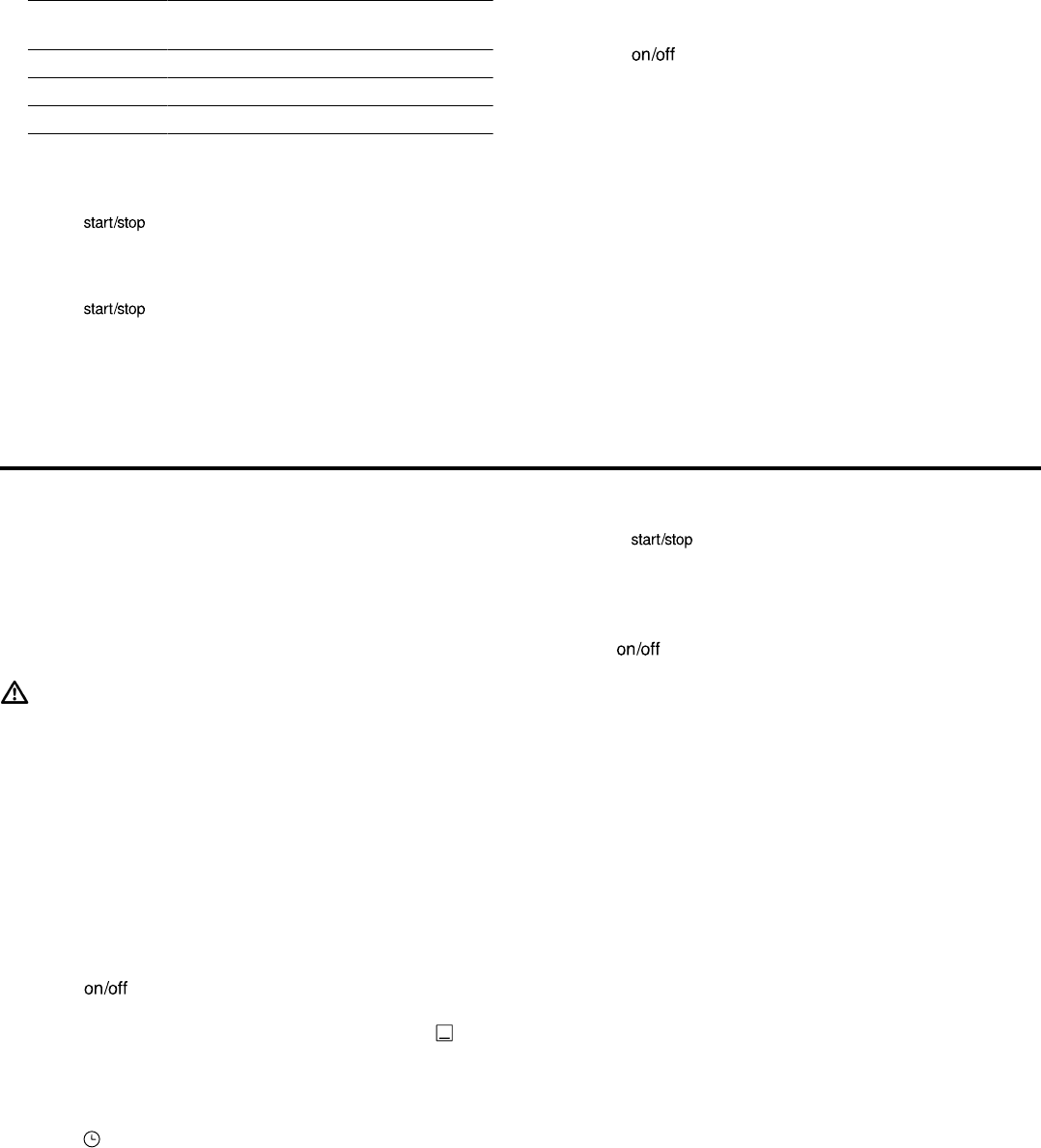
Cleaning assistance en
21
Cleaning set-
ting
Cleaning
level
Duration in hours
1 Light Approx. 1:15
2 Medium Approx. 1:30
3 High Approx. 2:00
Select a higher cleaning setting for heavier or older
soiling.
The duration cannot be changed.
4.
Press
.
a A notification stating that you should carry out the
necessary preparatory work for the cleaning func-
tion appears in the display.
5.
Press to start.
a The cleaning function starts and the duration counts
down. The heating line does not appear.
a For your safety, the appliance door locks once a
certain temperature is reached in the cooking com-
partment.
a When the cleaning function ends, a signal sounds
and the duration is at zero in the display.
6.
Press to switch the appliance off.
When the appliance has cooled down sufficiently,
the appliance door is unlocked and goes out.
7.
→"Preparing the appliance for use following the
cleaning function", Page21.
17.3 Preparing the appliance for use
following the cleaning function
1.
Allow the appliance to cool down.
2.
Wipe off any ash that has been left behind in the
cooking compartment, on the rails and around the
appliance door with a damp cloth.
3.
Remove white residues with lemon juice.
Note:White residues on the enamel surfaces may
be caused by heavy soiling. These food residues
are harmless. The deposits do not compromise the
functionality of the appliance.
18 Cleaning assistance
The cleaning assistance is a quick alternative for occa-
sionally cleaning the cooking compartment. The clean-
ing assistance softens dirt by vaporising the soapy wa-
ter. It is then easier to remove dirt.
18.1 Setting the cleaning aid
WARNING‒Risk of scalding!
If there is water in the cooking compartment when it is
hot, this may create hot steam.
▶ Never pour water into the cooking compartment
when the cooking compartment is hot.
Requirement:The cooking compartment has cooled
down completely.
1.
Remove the accessories from the cooking compart-
ment.
2.
Mix 0.4litres water with a drop of washing-up liquid
and pour into the centre of the cooking compart-
ment floor.
Do not use distilled water.
3.
Press
.
a A type of heating and a temperature appears.
4.
Use the rotary selector to set the bottom heat
type of heating.
5.
Press the temperature.
6.
Use the rotary selector to set the temperature to
80°C.
7.
Press .
8.
Use the rotary selector to set the time to
fourminutes.
9.
Press to start.
a The appliance starts to heat and the time starts to
count down.
a Once the time has elapsed, an audible signal
sounds. A message appears in the status bar.
10.
Use to switch the appliance off and leave the
cooking compartment to cool for approx.
20minutes.
18.2 Wiping down the cooking compartment
ATTENTION!
The prolonged presence of moisture in the cooking
compartment leads to corrosion.
▶ After using the cleaning assistance, wipe the cook-
ing compartment and allow it to dry completely.
Requirement:The cooking compartment must have
cooled down.
1.
Open the appliance door and remove the remaining
water with an absorbent sponge cloth.
2.
Clean the smooth surfaces in the cooking compart-
ment with a dish cloth or a soft brush. Remove stub-
born food remnants using a stainless steel scouring
pad.
3.
Remove limescale with a cloth soaked in vinegar.
Then wipe with clean water and rub dry with a soft
cloth (including under the door seal).
4.
In order to dry the cooking compartment, leave the
appliance door open in the detent position (approx.
30°) for approx.one hour.
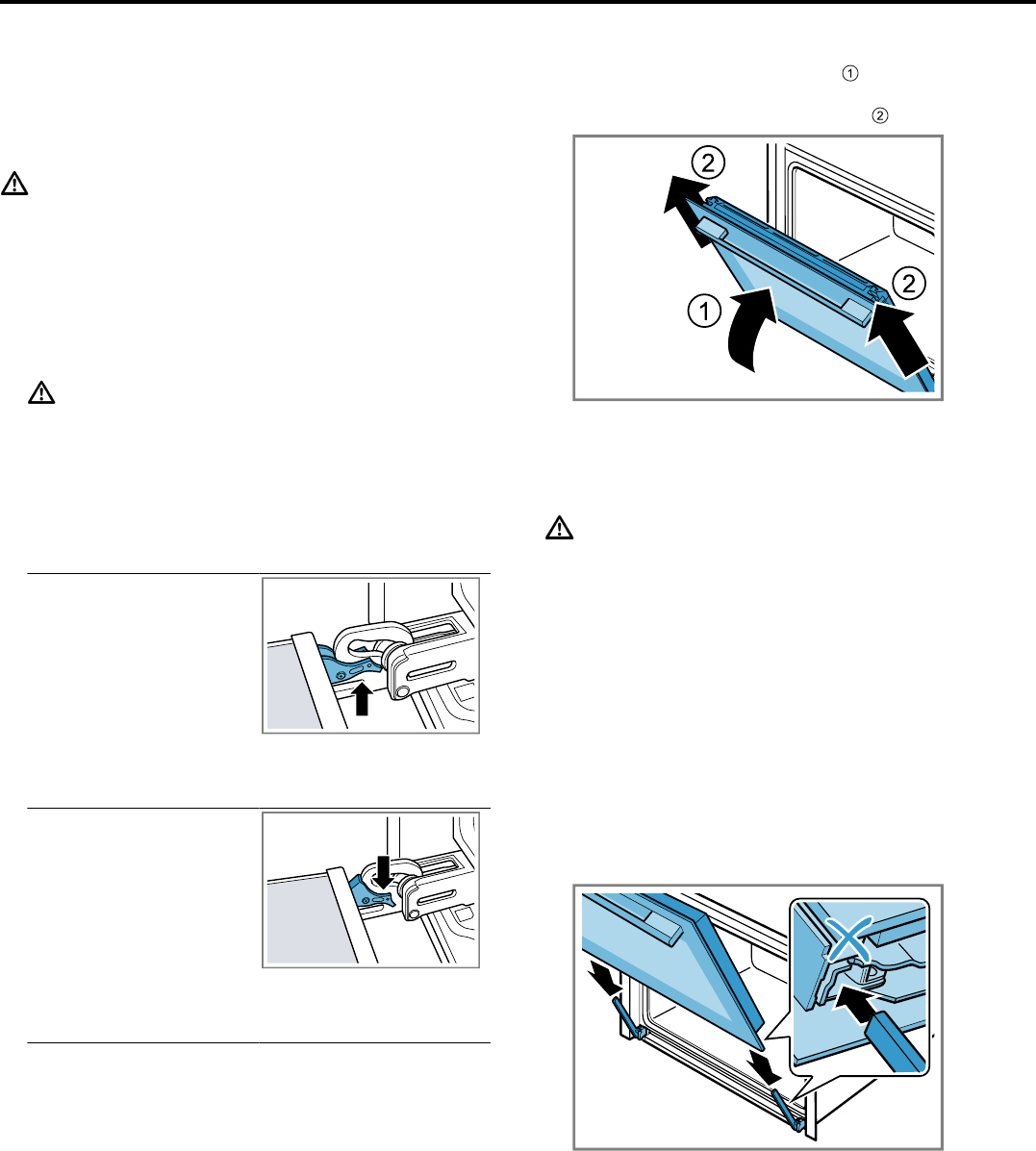
en Appliance door
22
19 Appliance door
To clean the appliance door thoroughly, you can disas-
semble the appliance door.
19.1 Detaching the appliance door
WARNING‒Risk of injury!
Components inside the appliance door may have sharp
edges.
▶ Wear protective gloves.
The hinges on the appliance door move when the door
is opened and closed, which could trap your fingers.
▶ Keep your hands away from the hinges.
1.
Open the appliance door fully and push in the direc-
tion of the appliance.
2.
WARNING‒Risk of injury!
When the hinges are not secured, they can snap
shut with great force.
▶ Make sure that the locking levers are always
either fully closed or (when detaching the oven
door) fully open.
Open the locking levers on the left- and right-hand
hinges.
Locking levers opened
The hinge is now se-
cured and cannot snap
shut.
Locking levers closed
The appliance door is
secured and cannot be
detached.
a The locking levers are open. The hinges are now se-
cured and cannot snap shut.
3.
Close the appliance door fully
. Grab hold of the
appliance door with both hands (on the left and
right) and pull it upwards and out .
4.
Carefully place the appliance door on a level sur-
face.
19.2 Attaching the appliance door
WARNING‒Risk of injury!
The hinges on the appliance door move when the door
is opened and closed, which could trap your fingers.
▶ Keep your hands away from the hinges.
When the hinges are not secured, they can snap shut
with great force.
▶ Make sure that the locking levers are always either
fully closed or (when detaching the oven door) fully
open.
1.
Note:Ensure that the appliance door slides onto the
hinges without any resistance. If you feel any resist-
ance, check whether you are sliding it in at the cor-
rect opening.
Slide the appliance door straight onto the two
hinges. Slide the appliance door on as far as it will
go.
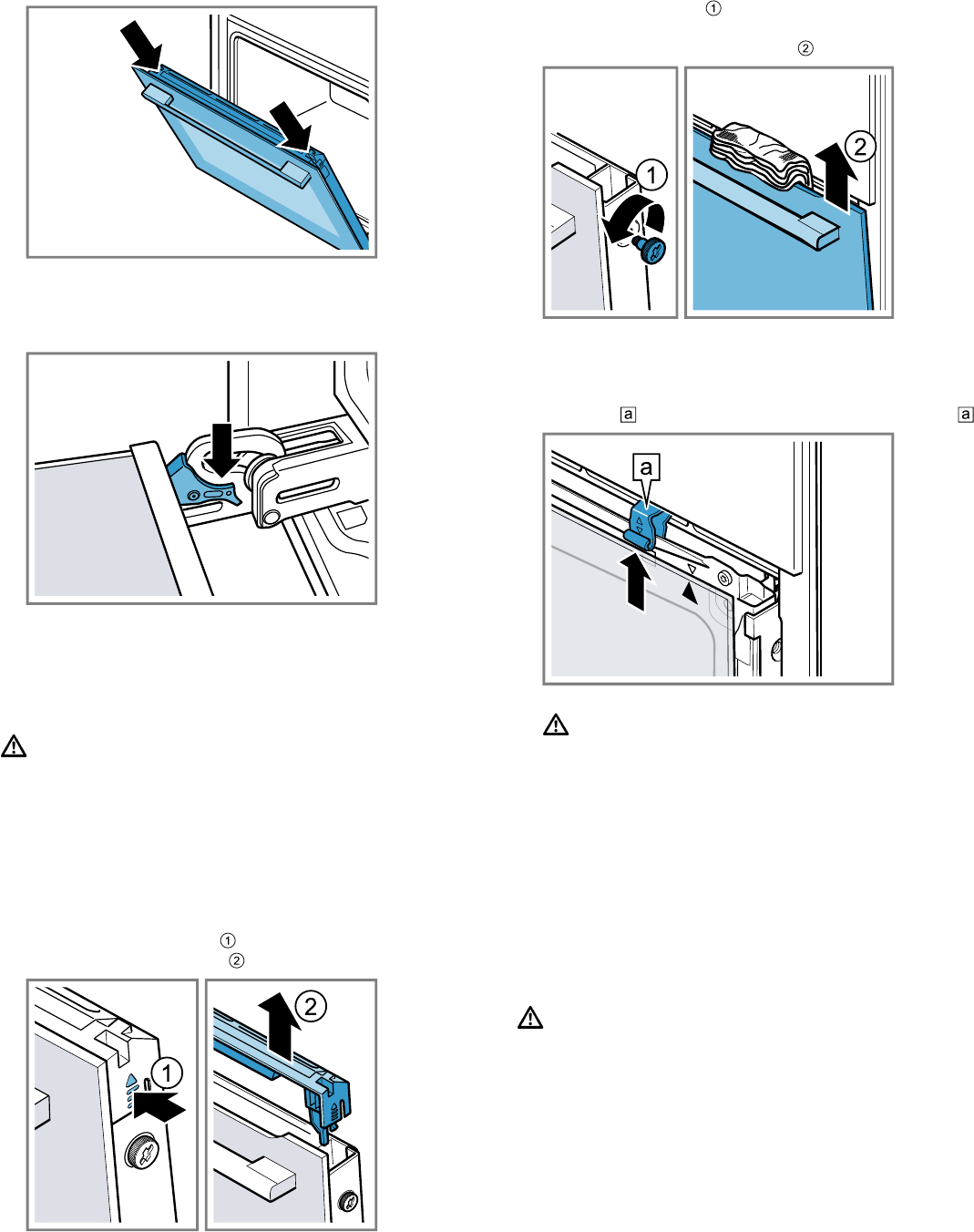
Appliance door en
23
2.
Using both hands, press down on the left and right
of the door cover from above to check whether the
appliance has been pushed in as far as it will go.
3.
Open the appliance door fully and push in the direc-
tion of the appliance.
4.
Close the locking levers on the left- and right-hand
hinges.
a The locking levers are closed. The appliance door is
secured and cannot be detached.
5.
Close the appliance door.
19.3 Removing the door panes
WARNING‒Risk of injury!
The hinges on the appliance door move when the door
is opened and closed, which could trap your fingers.
▶ Keep your hands away from the hinges.
Components inside the appliance door may have sharp
edges.
▶ Wear protective gloves.
1.
Open the appliance door slightly.
2.
Push on the left- and right-hand side of the door
cover from the outside
until it is released.
3.
Remove the door cover .
4.
Clean the door cover.
→"Suitable cleaning agents", Page19
5.
Undo and remove the left- and right-hand screws on
the appliance door
.
6.
Place a folded-up tea towel in the appliance door.
Pull the front pane up and out .
7.
Set the front pane down on a level surface with the
door handle facing down.
8.
Press the intermediate pane against the appliance
with one hand while pushing the left- and right-hand
retainers upwards. Do not detach the retainers .
9.
Remove the intermediate pane.
10.
WARNING‒Risk of injury!
Scratched glass in the appliance door may develop
into a crack.
▶ Do not use any harsh or abrasive cleaners or
sharp metal scrapers to clean the glass on the
oven door, as they may scratch the surface.
Clean the removed door panes on both sides with
glass cleaner and a soft cloth.
11.
Clean the appliance door.
→"Suitable cleaning agents", Page19
12.
Dry the door panes and refit them.
19.4 Fitting the door panes
WARNING‒Risk of injury!
The hinges on the appliance door move when the door
is opened and closed, which could trap your fingers.
▶ Keep your hands away from the hinges.
Components inside the appliance door may have sharp
edges.
▶ Wear protective gloves.
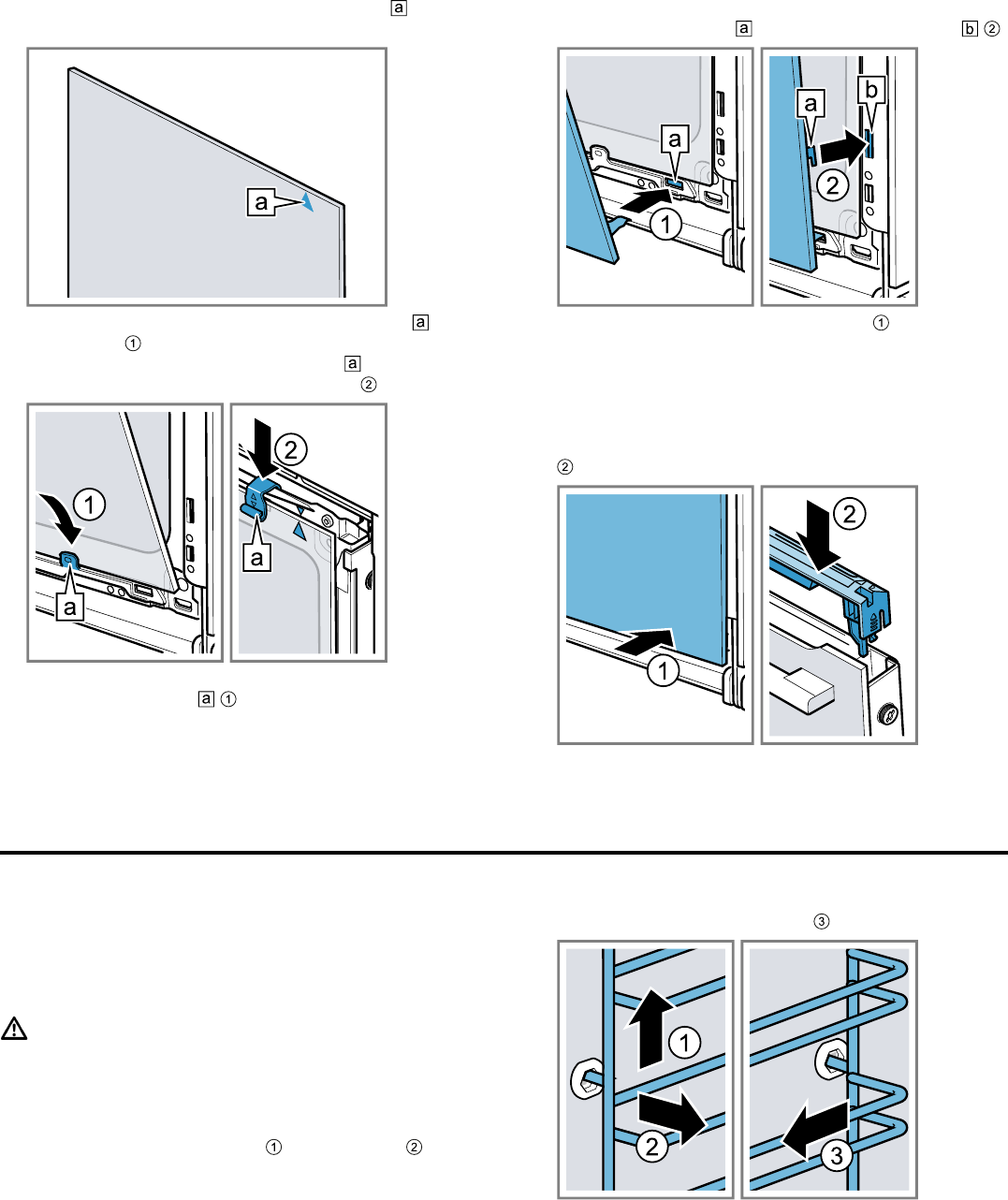
en Rails
24
1.
Turn the intermediate pane until the arrow
is in
the top right.
2.
Insert the intermediate pane into the retainer at
the bottom and push it in firmly at the top.
3.
Push the left- and right-hand retainer downwards
until the intermediate pane is clamped .
4.
Attach the front pane downwards into the left- and
right-hand retainers .
5.
Push the front pane to the appliance until the left-
and right-hand hook is opposite the support .
6.
Push the front pane in at the bottom until you
hear it click into place.
7.
Open the appliance door slightly and remove the
tea towel.
8.
Screw both screws back in on the left and right of
the appliance door.
9.
Put the door cover in position and push down on it
until you hear it click into place.
10.
Close the appliance door.
Note:Do not use the cooking compartment again until
the door panes have been correctly fitted.
20 Rails
To thoroughly clean the rails and the cooking compart-
ment, or to replace the rails, you can remove the rails.
20.1 Detaching the rails
WARNING‒Risk of burns!
The shelf supports get very hot
▶ Never touch the shelf supports when hot.
▶ Always allow the appliance to cool down.
▶ Keep children at a safe distance.
1.
Lift the rail forwards slightly and detach it .
2.
Pull the whole rail to the front and remove it.
3.
Clean the rail.
→"Cleaning products", Page18
20.2 Attaching the rails
Notes
¡ The rails only fit on the right or left.
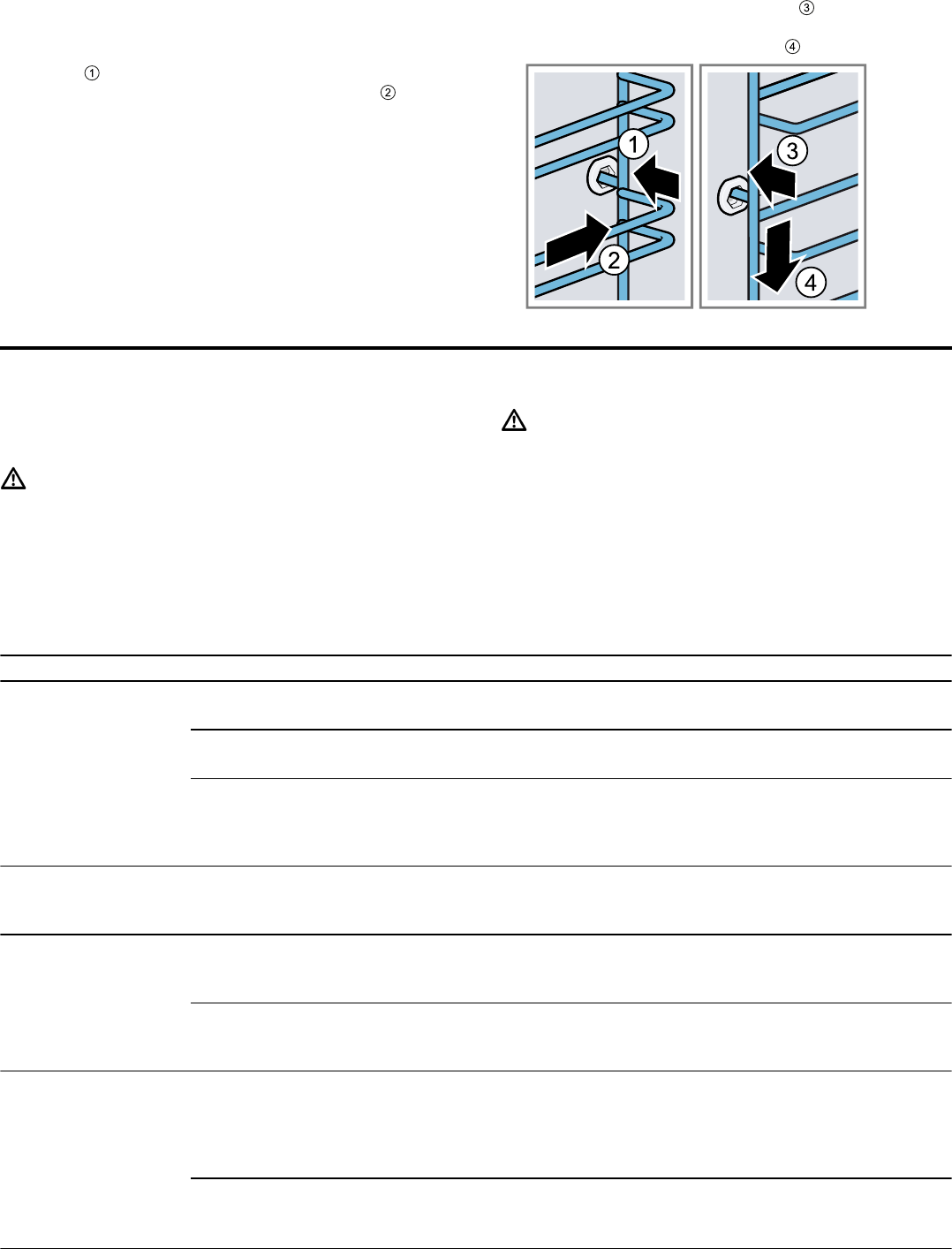
Troubleshooting en
25
¡ For both rails, ensure that the curved rods are at the
front.
1.
First, push the rail into the middle of the rear
socket
until the rail rests against the cooking
compartment wall, and then push this back .
2.
Push the rail into the front socket until the rail
also rests against the cooking compartment wall,
and then press this downwards .
21 Troubleshooting
You can rectify minor faults on your appliance yourself.
Read the troubleshooting information before contacting
after-sales service. This will avoid unnecessary costs.
WARNING‒Risk of injury!
Improper repairs are dangerous.
▶ Repairs to the appliance should only be carried out
by trained specialist staff.
▶ If the appliance is defective, call Customer Service.
WARNING‒Risk of electric shock!
Incorrect repairs are dangerous.
▶ Repairs to the appliance should only be carried out
by trained specialist staff.
▶ Only use genuine spare parts when repairing the
appliance.
▶ If the power cord of this appliance is damaged, it
must be replaced by trained specialist staff.
21.1 Malfunctions
Fault Cause and troubleshooting
The appliance is not
working.
The circuit breaker is faulty.
▶
Check the circuit breaker in the fuse box.
There has been a power cut.
▶
Check whether the lighting in your kitchen or other appliances are working.
Electronics fault
1.
Briefly disconnect the appliance from the power supply by switching off the fuse.
2.
Reset the basic settings to the factory settings.
→"Basic settings", Page18
"Sprache Deutsch"
appears in the dis-
play.
There has been a power cut.
▶
Implement the settings for the initial configuration.
→"Carrying out the initial configuration", Page11
The operation does
not start or is inter-
rupted.
Malfunction
▶
Call the after-sales service.
→"Customer Service", Page27
Different causes are possible.
▶
Check any notifications that appear in the display.
→"Displaying information", Page12
Appliance does not
heat up and "Demo
mode is switched on"
appears in the dis-
play.
Device is in demo mode.
1.
Briefly disconnect the appliance from the power supply by switching the circuit breaker in
the fuse box off and back on again.
2.
Switch off demo mode within three minutes in the
→"Basic settings", Page18.
There has been a power cut.
▶
Open and close the appliance door once after a power failure.
a The appliance is checked and is ready to use.
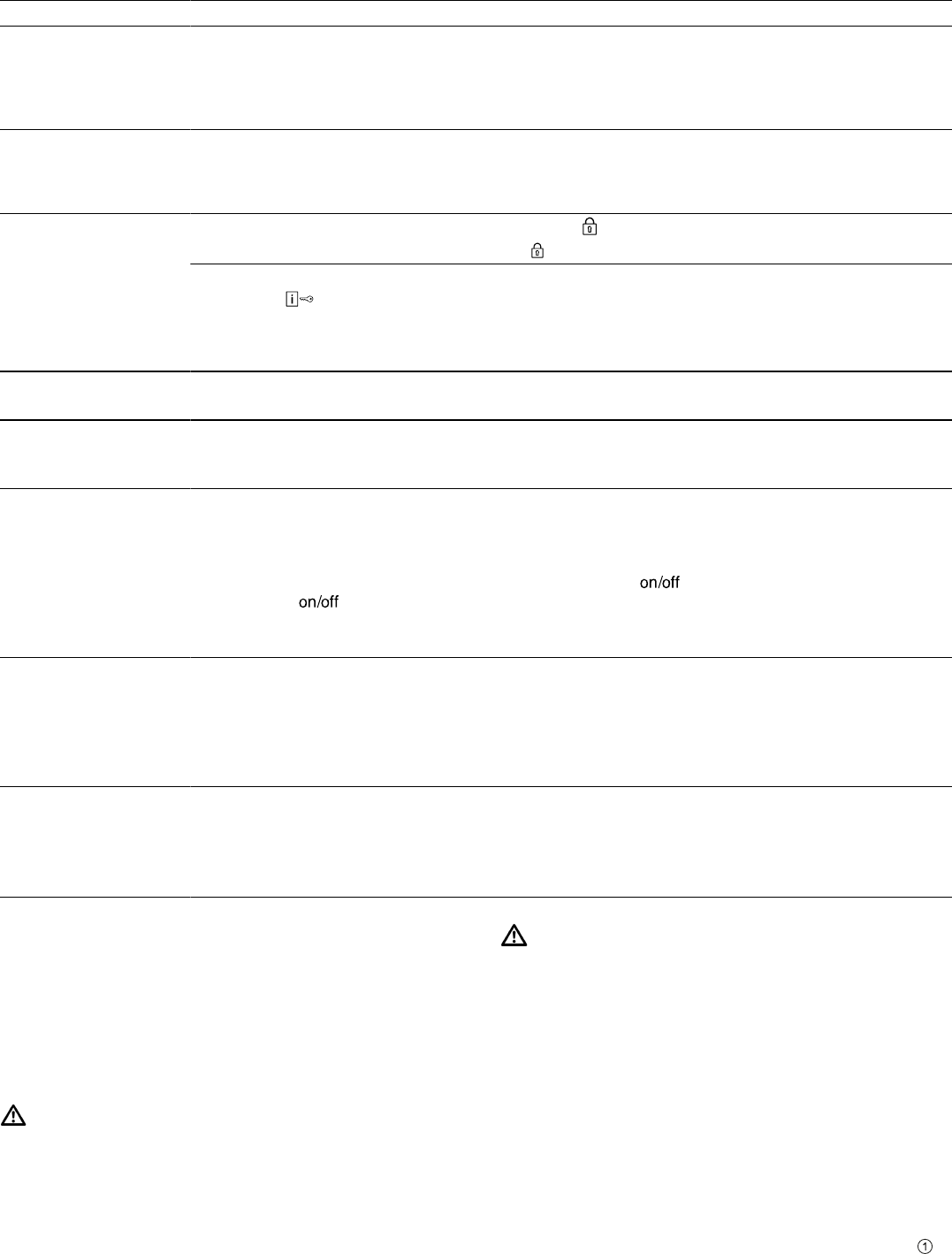
en Troubleshooting
26
Fault Cause and troubleshooting
The appliance does
not start and "Cook-
ing compartment too
hot" appears in the
display.
The cooking compartment is too hot for the selected dish or type of heating.
▶
Allow the cooking compartment to cool down and start again.
The time is not dis-
played when the ap-
pliance is switched
off.
Basic setting has been changed.
▶
Change the basic setting for the time display.
→"Basic settings", Page18
Appliance door can-
not be opened.
The cleaning function locks the appliance door; lights up in the display.
▶
Allow the appliance to cool down until goes out in the display.
The childproof lock locks the appliance door.
▶
Use the button to deactivate the childproof lock.
→"Childproof lock", Page15
You can switch off the lock in the basic settings.
→"Basic settings", Page18
HomeConnect is not
working correctly.
Different causes are possible.
▶
Go to www.home-connect.com.
The interior lighting
does not work.
The halogen lamp is defective.
▶
Change the oven light bulb.
→"Replacing the oven light bulb", Page26
Maximum operating
time reached.
To prevent an unwanted permanent operation, the appliance automatically stops heating
after several hours if the settings are unchanged. A message appears in the display.
The point at which the maximum operating time is reached is determined by the corres-
ponding settings for an operating mode.
1.
To continue operation, switch off the appliance with first.
2.
Then use to switch on the appliance and set the required operation.
Tip:To prevent the appliance from switching off when you do not want it to, set a cooking
time.
A message with "D"
or "E" appears in the
display, e.g. D0111
or E0111.
The electronics have detected a fault.
1.
Switch the appliance off and on again.
a If the fault was a one-off, the message disappears.
2.
If the message appears again, call the after-sales service. Please specify the exact error
message when calling.
→"Customer Service", Page27
The cooking result is
not satisfactory.
Settings were unsuitable.
Setting values, e.g. temperature or cooking time, depend on the recipe, quantity and food.
▶
Next time, set lower or higher values.
Tip:A lot of information about the food preparation and corresponding setting values
can be found on our website siemens-home.bsh-group.com .
21.2 Replacing the oven light bulb
If the light in the cooking compartment fails, change
the oven light bulb.
Note:Heat-resistant, 40-watt, 230 V halogen bulbs are
available from the after-sales service or specialist retail-
ers. Only use these bulbs. Hold the new halogen bulbs
only with a clean, dry towel. This increases the service
life of the bulb.
WARNING‒Risk of burns!
The appliance and its parts that can be touched be-
come hot during use.
▶ Caution should be exercised here in order to avoid
touching heating elements.
▶ Young children under 8 years of age must be kept
away from the appliance.
WARNING‒Risk of electric shock!
When changing the bulb, the bulb socket contacts are
live.
▶ Before replacing the bulb, ensure that the appliance
is switched off in order to prevent a potential electric
shock.
▶ Also unplug the appliance from the mains or switch
off the circuit breaker in the fuse box.
Requirements
¡ The appliance is disconnected from the power sup-
ply.
¡ The cooking compartment has cooled down.
¡ You have a new halogen bulb to replace the old one.
1.
Place a tea towel in the cooking compartment to
prevent damage.
2.
Turn the glass cover anti-clockwise to remove it
.
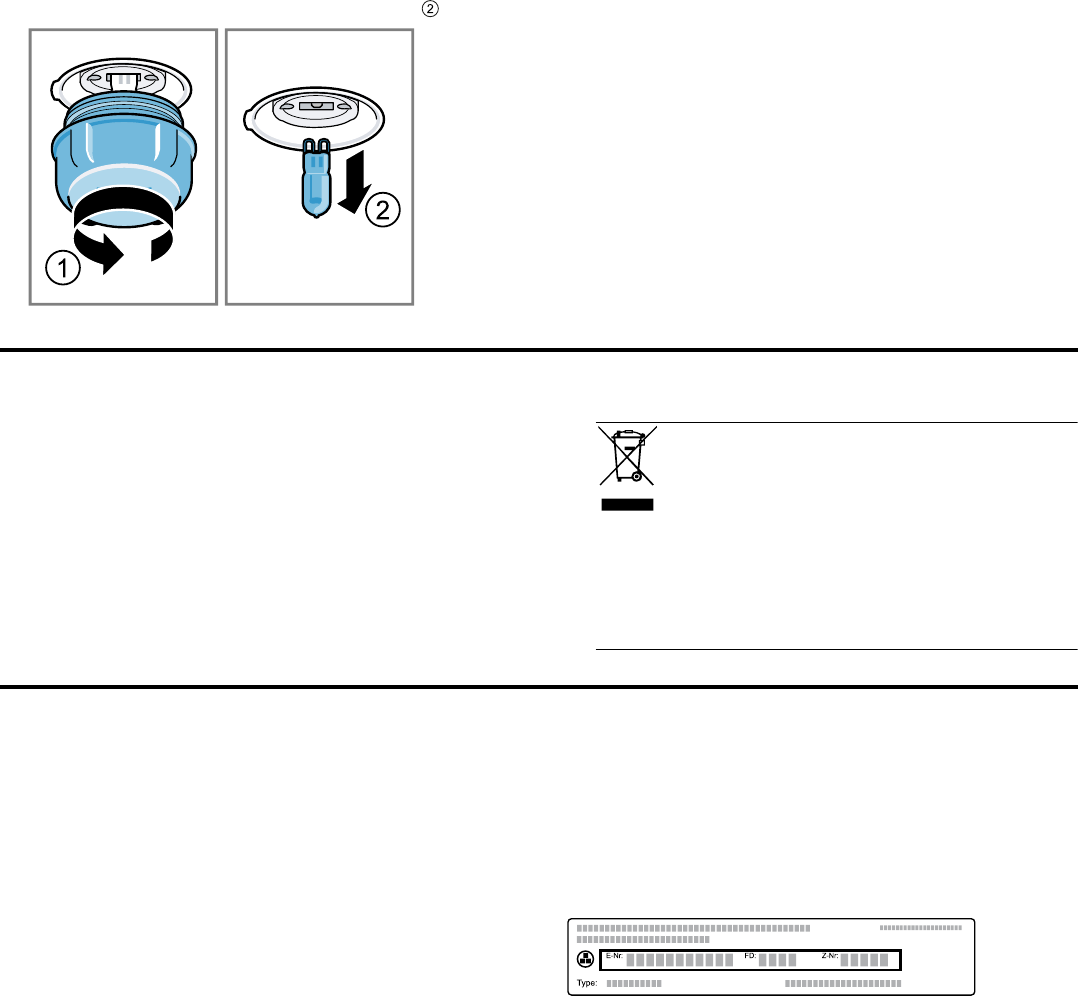
Disposal en
27
3.
Pull out the halogen bulb without turning it
.
4.
Insert the new halogen lamp and press it firmly into
the socket.
Make sure the pins are positioned correctly.
5.
Depending on the appliance model, the glass cover
may have a sealing ring. Put the sealing ring in posi-
tion.
6.
Screw the glass cover on.
7.
Take the tea towel out of the cooking compartment.
8.
Connect the appliance to the power supply.
22 Disposal
22.1 Disposing of old appliance
Valuable raw materials can be reused by recycling.
1.
Unplug the appliance from the mains.
2.
Cut through the power cord.
3.
Dispose of the appliance in an environmentally
friendly manner.
Information about current disposal methods are
available from your specialist dealer or local author-
ity.
This appliance is labelled in accord-
ance with European Directive
2012/19/EU concerning used elec-
trical and electronic appliances
(waste electrical and electronic equip-
ment - WEEE).
The guideline determines the frame-
work for the return and recycling of
used appliances as applicable
throughout the EU.
23 Customer Service
Function-relevant genuine spare parts according to the
corresponding Ecodesign Order can be obtained from
Customer Service for a period of at least 10 years from
the date on which your appliance was placed on the
market within the European Economic Area.
Note:Under the terms of the manufacturer's warranty
the use of Customer Service is free of charge.
Detailed information on the warranty period and terms
of warranty in your country is available from our after-
sales service, your retailer or on our website.
If you contact Customer Service, you will require the
product number (E-Nr.) and the production number
(FD) of your appliance.
The contact details for Customer Service can be found
in the enclosed Customer Service directory or on our
website.
23.1 Product number (E-Nr.) and production
number (FD)
You can find the product number (E-Nr.) and the pro-
duction number (FD) on the appliance's rating plate.
You will see the rating plate with these numbers if you
open the appliance door.
Make a note of your appliance's details and the Cus-
tomer Service telephone number to find them again
quickly.

en Declaration of Conformity
28
24 Declaration of Conformity
BSH Hausgeräte GmbH hereby declares that the appli-
ance with Home Connect functionality conforms to the
basic requirements and other relevant provisions of Dir-
ective 2014/53/EU.
A detailed RED Declaration of Conformity can be found
online at siemens-home.bsh-group.com among the ad-
ditional documents on the product page for your appli-
ance.
Hereby, BSH Hausgeräte GmbH declares that the ap-
pliance with HomeConnect functionality is in compli-
ance with relevant statutory requirements.
1
A detailed Declaration of Conformity can be found on-
line at siemens-home.bsh-group.com/uk/ among the
additional documents on the product page for your
appliance.
1
Only applies to Great Britain
2.4 GHz band (2400–2483.5MHz): Max. 100mW
5 GHz band (5150–5350MHz + 5470–5725MHz):
Max. 100mW
BE BG CZ DK DE EE IE EL ES
FR HR IT CY LI LV LT LU HU
MT NL AT PL PT RO SI SK FI
SE NO CH TR IS UK (NI)
5GHz WLAN (Wi-Fi): For indoor use only.
AL BA MD ME MK RS UK UA
5GHz WLAN (Wi-Fi): For indoor use only.
25 How it works
Here, you can find the ideal settings for various types
of food as well as the best accessories and cookware.
We have perfectly tailored these recommendations to
your appliance.
25.1 General cooking tips
Please take note of the following information when
cooking all types of food.
¡ The temperature and cooking time depend on the
amount of food and the recipe. Settings ranges are
specified for this reason. Try using the lower values
to start with.
¡ The setting values apply to food placed in the cook-
ing compartment while the cooking compartment is
still cold. Do not place accessories into the cooking
compartment until it has finished preheating.
¡ Remove any accessories that are not being used
from the cooking compartment.
25.2 Baking tips
¡ Dark-coloured metal baking tins are most suitable
for baking cakes, bread and other baked goods.
¡ Use wide, shallow cookware for bakes and gratins.
Food takes longer to cook in deep, narrow cook-
ware and it browns more on top.
¡ If you are cooking bakes directly in the universal
pan, place the universal pan into the cooking com-
partment at level2.
¡ The setting values for bread dough apply to both
dough placed on a baking tray and dough placed in
a loaf tin.
ATTENTION!
When the cooking compartment is hot, any water in-
side it will create steam. The change in temperature
may cause damage.
▶ Never pour water into the cooking compartment
when it is still hot.
▶ Never place cookware containing water on the
cooking compartment floor.
Shelf positions
If you are using the 4Dhot air heating function, you
can choose between shelf positions 1, 2, 3 and 4.
Baking on one level Shelf position
Tall baked items and tins/dishes on
the wire rack
2
Shallow baked items/baking trays 3
Baking on two or more levels Shelf position
2levels
¡ Universal pan
¡ Baking tray
3
1
2levels
¡ Baking tins on two wire racks
3
1
1
Only applies to Great Britain

How it works en
29
Baking on two or more levels Shelf position
3levels
¡ Baking tray
¡ Universal pan
¡ Baking tray
5
3
1
4levels
¡ 4 wire racks with greaseproof pa-
per
5
3
2
1
Use the 4Dhot air heating function.
Note:Items that are placed in the appliance on baking
trays or in baking tins/dishes at the same time will not
necessarily be ready at the same time.
25.3 Roasting, braising and grilling tips
¡ The recommended settings are for fridge-temperat-
ure food and unstuffed, oven-ready poultry.
¡ Place the poultry onto the cookware breast-side or
skin-side down.
¡ Turn roasting joints, grilled items or whole fish after
approx. ½ to ⅔ of the specified time.
Calculating the cooking time, e.g. 20+35:
¡ To calculate the cooking time, assume 20minutes
per 500g of meat. Then add an extra 35minutes to
that figure.
¡ For 1.5kg, the cooking time would therefore be
95minutes.
Cooking time range, e.g. 10-15:
¡ Your food will be ready within the specified range of
time (in minutes).
Roasting on the wire rack
Food roasted on the wire rack will become very crispy
on all sides. You can roast large poultry, for example,
or multiple individual pieces at the same time.
¡ Roast pieces of a similar weight and thickness. The
grilled food will brown evenly and will remain succu-
lent and juicy.
¡ Place the food to be roasted directly on the wire
rack.
¡ To catch any liquids that drip down, place the uni-
versal pan, with the wire rack inside it, into the cook-
ing compartment at the specified shelf height.
¡ Add up to ½litre of water to the universal pan, de-
pending on the size and type of food that you want
to roast.
You can make a sauce from the juices that are col-
lected. This also means that less smoke is pro-
duced and the cooking compartment does not be-
come as dirty.
Roasting in cookware
If you cover the cookware when you cook your food,
this will keep the cooking compartment cleaner.
General information about roasting in cookware
¡ Use heat-resistant, ovenproof cookware.
¡ Place the cookware on the wire rack.
¡ Glass cookware is best.
¡ Follow the manufacturer's instructions for your roast-
ing dishes.
Roasting in uncovered cookware
¡ Use a deep roasting dish.
¡ If you do not have any suitable cookware, you can
use the universal pan.
Roasting in covered cookware
¡ Use a suitable lid that seals well.
¡ When roasting meat, there should be at least 3cm
between the food and the lid. The meat may ex-
pand.
WARNING‒Risk of scalding!
Very hot steam may escape when the lid is opened
after cooking. Steam may not be visible, depending on
the temperature.
▶ Lift the lid in such a way that the hot steam can es-
cape away from you.
▶ Keep children away from the appliance.
Grilling
Grill food if you want it to be crispy.
ATTENTION!
Acidic food may damage the grid
▶ Do not place acidic food, such as fruit or food with
an acidic marinade directly on the pan support.
The "Grill" heating function is good for cooking thinner
pieces of poultry, meat and fish such as steaks, drum-
sticks and burgers. It is also excellent for toasting
bread.
Circulated air grilling is very well suited to cooking
whole poultry and fish, as well as meat, e.g. roast pork
with crackling.
¡ When grilling several food items, choose pieces that
are of a similar weight and thickness. The grilled
food will brown evenly and will remain succulent
and juicy.
¡ Place the food to be grilled directly onto the wire
rack.
¡ To catch any liquids that drip down, place the uni-
versal pan into the cooking compartment at least
one level below the wire rack.
Notes
¡ The grill element switches on and off continuously.
This is normal. The grill setting that you use determ-
ines how frequently this occurs.
¡ Smoke may be produced when grilling.
Information for those allergic to nickel
In rare cases, small amounts of nickel may pass into
the food.
25.4 Cooking instructions for ready meals
¡ The cooking result greatly depends on the quality of
the food. Pre-browning and irregularities are some-
times already present on the raw product.
¡ Do not use frozen products that are covered with a
thick layer of ice. Remove any ice on the food.
¡ Distribute foods that are in the form of separate
pieces, such as bread rolls and potato products, so
that they are spread out flat and evenly on the ac-
cessory. Leave a little space between the individual
pieces.
¡ Follow the manufacturer's instructions on the pack-
aging.

en How it works
30
25.5 List of foods
Recommended settings for a variety of foods, sorted into food categories.
Recommended settings for various types of food
Food Accessory/cookware Shelf pos-
ition
Heating
function
→Page8
Temperature in
°C
Cooking time in
mins
Victoria sponge cake x2
Baking tin, dia.
20cm
2 160–170
1
20–25
Rich fruit cake High Ø23cm tin 2 130–150 150–180
Rich fruit cake High Ø23cm tin 2 140–160 120–180
Fruit pie Plate Ø20cm
or
Pie tin
2 160–170 55–65
Fruit pie Plate Ø20cm
or
Pie tin
2 170–190 60–75
Quiche Dark coated quiche
tin
3 190–210 35–45
Bread or white bread Loaf tin, 1 x 900g or
2 x 450g
2 180–200
1
20–30
Bread or white bread Loaf tin, 1 x 900g or
2 x 450g
2 190–200 40–50
Scones Baking tray 3 180–200
1
10–14
Biscuits Baking tray 3 140–160
1
10–25
Small cakes 12-cup-tin 3 140–160
1
20–30
Pavlova Baking tray 3 90–100
1
120–180
Yorkshire pudding 12-cup-tin 3 200–220
1
15–25
Pizza, home-made Baking tray 3 200–220 25–35
Pizza, home-made, thin crust Pizza tray 2 210–220 25–30
Victoria sponge cake, 2 levels 4 pcs
Baking tin, dia.
20cm
3+1 160–170
1
20–25
Biscuits, on 2levels x2
Baking tray
3+1 140 - 160
1
10 - 25
Biscuits, on 3levels x3
Baking tray
5+3+1 140 - 160
1
15 - 30
Top side, top rump Wire rack 2 160 - 170 30 + 25
Leg, bone-in Wire rack 2 160 - 170 25 + 25
Belly Wire rack 2 170 - 180 30 + 25
Chicken, whole Wire rack 2 170 - 180 25 + 15
Turkey, crown Wire rack 2 150 - 160 20 + 15
Turkey, whole, 4-8kg Wire rack 2 150 - 160 12 + 12
2
Diced meat, e.g. beef, pork,
lamb, 500g meat
Covered cookware 2 140
1
100 - 120
Diced meat, e.g. beef, pork,
lamb, 500g meat
Covered cookware 2 140 100–120
1
Preheat the appliance.
2
Turn the food after approx. one hour.
3
Preheat the appliance for 5 minutes.
4
Preheat the appliance for three minutes.
5
Turn the dish several times.

How it works en
31
Food Accessory/cookware Shelf pos-
ition
Heating
function
→Page8
Temperature in
°C
Cooking time in
mins
Complete meal with chicken Wire rack
+
Wire rack
4+1 180 Calculation for
chicken (see
table above)
Bacon rashers Wire rack 3 3
3
1. First side 4-5
2. Second side
3-4
Sausages, 2-4cm thick Wire rack 3 3
4
10 - 15
5
Belly Wire rack 2 200 - 220 30 + 25
Gammon joint Wire rack 2 180 - 200 30 + 25
Chicken, whole Wire rack 2 200–220 20 + 15
Yoghurt Individual moulds Cooking
compart-
ment floor
40 - 45 8-9 hrs
1
Preheat the appliance.
2
Turn the food after approx. one hour.
3
Preheat the appliance for 5 minutes.
4
Preheat the appliance for three minutes.
5
Turn the dish several times.
25.6 Special cooking methods and other
applications
Information and recommended settings for special
cooking methods and other applications, e.g. slow
cooking or preserving.
Yoghurt
Use your appliance to make yoghurt.
Making yoghurt
1.
Remove the accessories and shelves from the
cooking compartment.
2.
Heat 1litre of whole milk (3.5% fat) to 90°C on the
hob and then leave it to cool down to 40°C.
It is sufficient to heat UHT milk to 40°C.
3.
Mix 150g of chilled yoghurt into the milk.
4.
Pour the mixture into small containers, e.g. cups or
small jars.
5.
Cover the containers with film, e.g. cling film.
6.
Place the containers on the cooking compartment
floor.
7.
Use the recommended settings when configuring
the appliance settings.
8.
After making the yoghurt, leave it to cool in the refri-
gerator for at least 12hours.
Recommended settings for yoghurt
Food Accessory/cookware Shelf pos-
ition
Heating
function
→Page8
Temperature in
°C
Cooking time in
mins
Yoghurt Individual moulds Cooking
compart-
ment floor
40 - 45 8-9 hrs
Slow cooking
Cook prime cuts of meat slowly at a low temperature,
e.g. tender cuts of beef, veal, lamb or poultry.
Slow cooking poultry or meat
Note:When using the slow cooking type of heating,
you cannot delay the start of the programme by setting
an end time.
Requirement:The cooking compartment is cold.
1.
Use fresh, clean, hygienic meat without bones.
2.
Place the cookware onto the wire rack at level 2 in
the cooking compartment.
3.
Preheat the cooking compartment and cookware for
approx. 15minutes.
4.
Sear the meat on all sides on the hob at a very high
heat.
5.
Immediately place the meat into the pre-warmed
cookware in the cooking compartment.
To ensure that the climate in the cooking compart-
ment remains constant, keep the cooking compart-
ment door closed during slow cooking.
6.
After slow cooking, remove the meat from the cook-
ing compartment.
Tips for slow cooking
Here you will find tips for achieving good results when
slow cooking food.

en How it works
32
Issue Tip
You want to slow
cook a duck breast.
¡ Place the cold duck breast
into a pan.
¡ Sear the skin side first.
¡ Slow cook the duck breast.
¡ After slow cooking, grill the
duck breast for 3 to
5minutes until crispy.
Issue Tip
You want to serve
your slow-cooked
meat as hot as pos-
sible.
¡ Preheat the serving plate.
¡ Make sure that the sauces
that accompany the duck
breast are very hot when
you serve them.
Recommended settings for slow cooking
Food Accessory/cook-
ware
Shelf pos-
ition
Searing
time in
mins
Heating function
→Page8
Temperature
in °C
Cooking
time in
mins
Duck breast, medium
rare, 300g each
Uncovered cook-
ware
2 6 - 8 90
1
45 - 60
Fillet of pork, whole Uncovered cook-
ware
2 4 - 6 80
1
45 - 70
Fillet of beef, 1kg Uncovered cook-
ware
2 4 - 6 80
1
90 - 120
Veal medallions, 4cm
thick
Uncovered cook-
ware
2 4 80
1
30 - 50
Saddle of lamb, bone-
less, 200g each
Uncovered cook-
ware
2 4 80
1
30 - 45
1
Preheat the appliance.
Defrosting
You can defrost frozen food in your appliance.
Tips for defrosting food
¡ You can use the appliance to defrost frozen fruit, ve-
getables or baked goods.
¡ It is better to defrost poultry, meat and fish in the re-
frigerator.
¡ Remove frozen food from its packaging before you
defrost it.
¡ The recommended settings are for freezer-temperat-
ure food (-18°C).
¡ When defrosting food, use the following shelf posi-
tions:
– 1 wire rack: Shelf position 2
– 2 wire racks: Shelf positions 3+1
¡ Stir or turn the food 1-2times during defrosting.
Turn large items several times. Split the food into
smaller pieces as it defrosts.
Remove pieces that have already defrosted from the
cooking compartment.
¡ Once the food has defrosted, switch off the appli-
ance and leave the food in the appliance for another
10 to 30minutes to allow the temperature to equal-
ise.
25.7 Test dishes
The information in this section is provided for test institutes to facilitate testing of the appliance in accordance with
EN 60350‑1.
Baking
¡ The setting values apply to food that is placed into a
cold cooking compartment.
¡ Please take note of the information on preheating in
the recommended settings tables. These setting val-
ues assume that the rapid heat-up function is not
being used.
¡ For baking, use the lower of the specified temperat-
ures to start with.
¡ Items that are placed in the appliance on baking
trays or in baking tins/dishes at the same time will
not necessarily be ready at the same time.
¡ Shelf positions when baking on 2levels:
– Universal pan: Shelf position3
Baking tray: Shelf position1
– Baking tins/dishes on the wire rack:
First wire rack: Shelf position3
Second wire rack: Shelf position1
¡ Shelf positions when baking on 3levels:
– Baking tray: Shelf position5
– Universal pan: Shelf position3
– Baking tray: Shelf position1
¡ Hot water sponge cake
– When baking on two levels, place the springform
tins at diagonally opposite corners of the wire
racks.
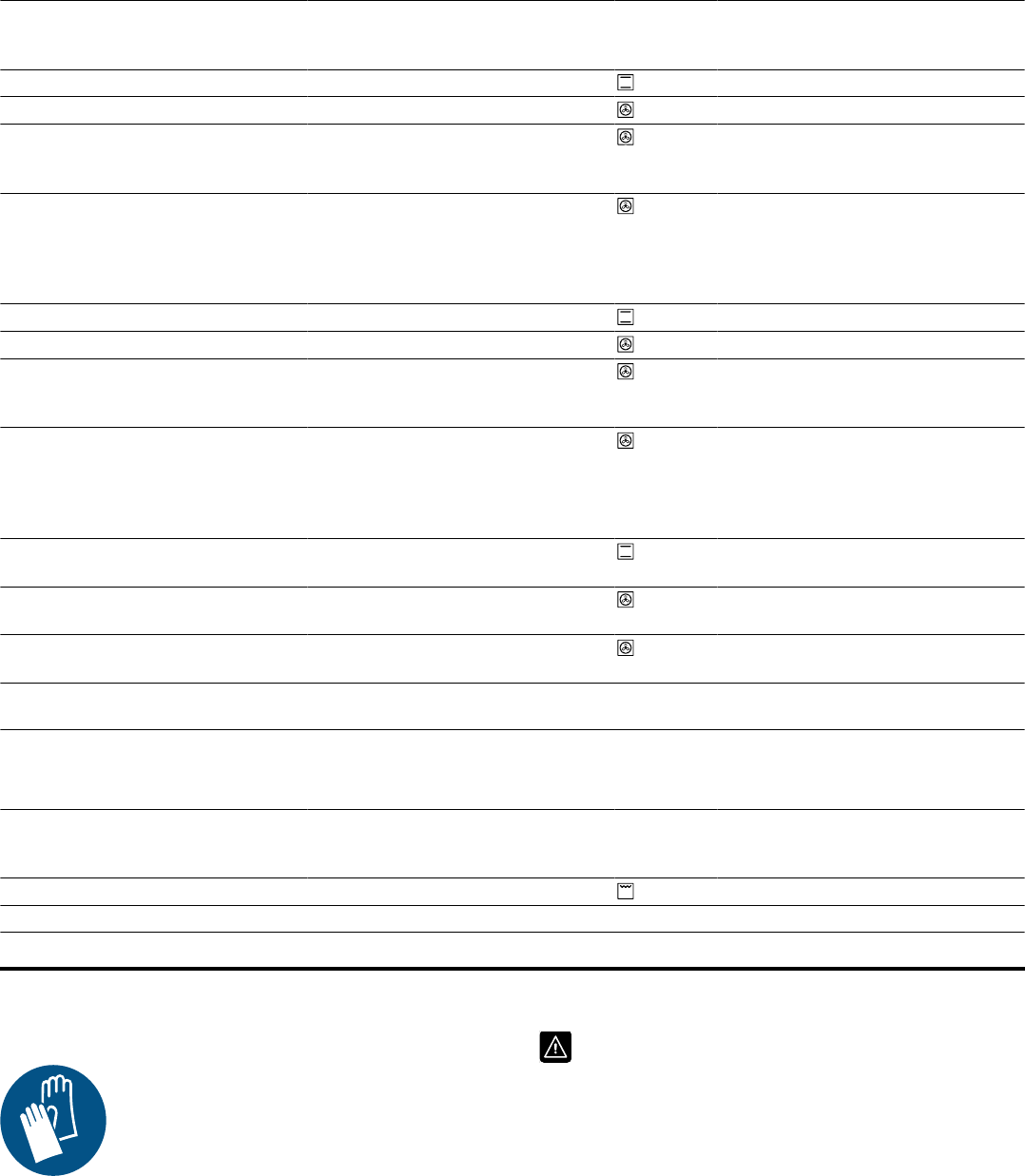
Installation instructions en
33
Recommended settings for baking
Food Accessory/cookware Shelf pos-
ition
Heating
function
→Page8
Temperature in
°C
Cooking time in
mins
Viennese whirls Baking tray 3 140 - 150
1
25 - 40
Viennese whirls Baking tray 3 140 - 150
1
25 - 40
Viennese whirls, on 2levels Universal pan
+
Baking tray
3+1 140 - 150
1
30 - 40
Viennese whirls, on 3levels x2
Baking tray
+
x1
Universal pan
5+3+1 130 - 140
1
35 - 55
Small cakes Baking tray 3 160
1
20 - 30
Small cakes Baking tray 3 150
1
25 - 35
Small cakes, on 2levels Universal pan
+
Baking tray
3+1 150
1
25 - 35
Small cakes, on 3levels x2
Baking tray
+
x1
Universal pan
5+3+1 140
1
35 - 45
Hot water sponge cake Springform cake tin,
diameter 26 cm
2 160 - 170
2
25 - 35
Hot water sponge cake Springform cake tin,
diameter 26 cm
2 160 - 170
2
30 - 40
Hot water sponge cake, on
2levels
Springform cake tin,
diameter 26 cm
3+1 150 - 170
2
30 - 50
1
Preheat the appliance for five minutes. Do not use the rapid heating function.
2
Preheat the appliance. Do not use the rapid heating function.
Recommended settings for grilling
Food Accessory/cookware Shelf pos-
ition
Heating
function
→Page8
Temperature in
°C/grill setting
Cooking time in
mins
Toasting bread Wire rack 5 3
1
4 - 6
1
Do not preheat the appliance.
26 Installation instructions
Observe this information when installing the appliance.
26.1 General installation instructions
Follow these instructions before you start with
the installation of the appliance.
¡ The safe operation of this appliance can
only be guaranteed if it has been installed
to a professional standard in accordance
with these installation instructions. The in-
staller shall be liable for damages incurred
as a result of incorrect installation.
¡ Do not use the door handle for the trans-
port or installation.
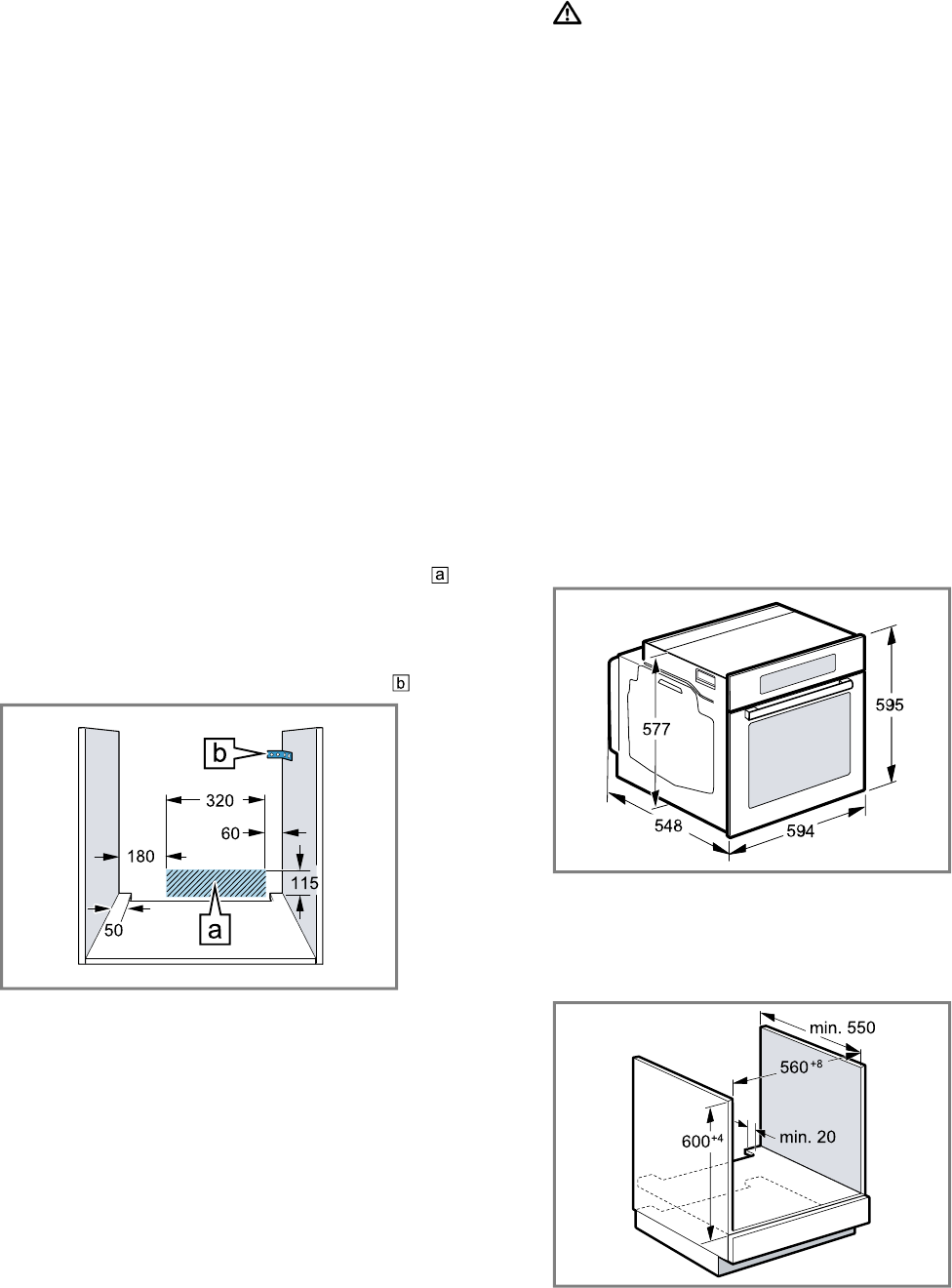
en Installation instructions
34
¡ Check the appliance for damage after un-
packing it. Do not connect the appliance if
it has been damaged in transit.
¡ Before starting up the appliance, remove
any packaging material and adhesive film
from the cooking compartment and the
door.
¡ Proceed in accordance with the installation
sheets for installing accessories.
¡ Fitted units must be heat-resistant up to
95°C, and adjacent unit fronts up to
70°C.
¡ Do not install the appliance behind a decor-
ative door or the door of a kitchen unit.
There is a risk of overheating.
¡ Cut-out work on the units should be carried
out before installing the appliance. Remove
any shavings. Otherwise, the correct opera-
tion of electrical components may be ad-
versely affected.
¡ The mains socket for the appliance must
either be located in the hatched area
or
outside of the area where the appliance is
installed.
Any unsecured units must be secured to
the wall using a standard bracket
.
¡ Wear protective gloves so that you do not
cut yourself. Parts that are accessible dur-
ing installation may have sharp edges.
¡ Dimensions of the figures in mm.
WARNING‒Risk of fire!
It is dangerous to use an extended power
cord and non-approved adapters.
▶ Do not use multiple socket strips.
▶ Only use extension cables that are certified,
have a minimum cross section of 1.5mm²
and comply with the applicable national
safety requirements.
▶ If the power cord is too short, contact cus-
tomer service.
▶ Only use adapters approved by the manu-
facturer.
ATTENTION!
Carrying the appliance by the door handle
could break it. The door handle cannot sup-
port the weight of the appliance.
▶ Do not carry or hold the appliance by the
door handle.
26.2 Appliance dimensions
You will find the dimensions of the appliance here
26.3 Installation below a worktop
Observe the installation dimensions and the installation
instructions when installing below a worktop.
¡ To ventilate the appliance, the intermediate floor
must have a ventilation cut-out.
¡ The worktop must be secured to the built-in unit.
¡ Observe any available installation instructions for the
hob.

Installation instructions en
35
26.4 Installation underneath a hob
If the appliance is installed under a hob, the following
minimum dimensions must be adhered to (including
substructure, if applicable).
The minimum worktop thickness a is based on the
required minimum clearance .
Hob type a raised in mm a flush in mm b in mm
Induction hob 37 38 5
Full-surface induction hob 47 48 5
Gas hob 27 38 5
Electric hob 27 30 2
26.5 Installation in a tall unit
Observe the installation dimensions and the installation
instructions when installing in a tall unit.
¡ To ventilate the appliance, the intermediate floors
must have a ventilation cut-out.
¡ If the tall unit has another back panel in addition to
the element back panels, this must be removed.
¡ Only fit the appliance up to a height which allows
accessories to be easily removed.
26.6 Installing two appliances on top of
each other
Your appliance can also be installed above or below
another appliance. Observe the installation dimensions
and the installation instructions when installing appli-
ances on top of each other.
¡ To ventilate the appliances, the intermediate floor
must have a ventilation cut-out.
¡ To ensure sufficient ventilation of the two appli-
ances, there must be a ventilation opening of at
least 200cm² in the base area. To do this, trim the
base panel or fit a ventilation grille.
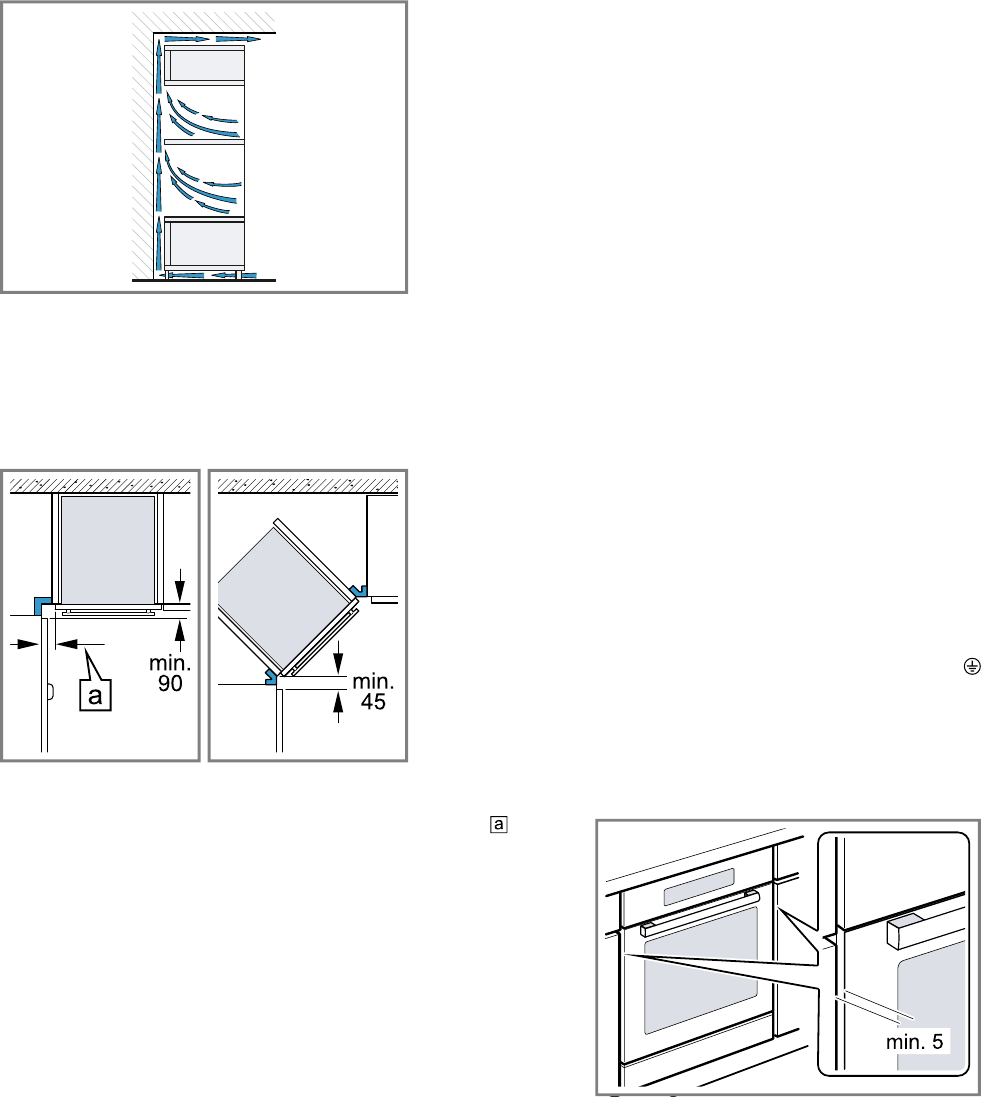
en Installation instructions
36
¡ Ensure that air exchange is guaranteed in accord-
ance with the diagram.
¡ Only fit appliances up to a height that allows ac-
cessories to be easily removed.
26.7 Corner installation
Observe the installation dimensions and the installation
instructions when installing in a corner.
¡ To ensure that the appliance door can be opened,
you must take the minimum dimensions into consid-
eration when installing in a corner. The dimension
is dependent on the thickness of the unit front and
the handle.
26.8 Electrical connection
In order to safely connect the appliance to the elec-
trical system, follow these instructions.
¡ The appliance corresponds to protection class I and
must only be operated with a protective earth con-
nection.
¡ The fuse protection must correspond to the power
rating specified on the appliance's rating plate and
to local regulations.
¡ The appliance must be disconnected from the
power supply whenever installation work is being
carried out.
¡ The appliance must only be connected using the
power cable provided.
¡ The power cable must be plugged in at the rear of
the appliance until you hear a clicking sound. A 3 m
power cable can be obtained from the after-sales
service.
¡ The power cable must only be replaced with a cable
from the original manufacturer. This is available from
after-sales service.
¡ Contact protection must be guaranteed by the in-
stallation.
Electrically connect the appliance with the
protective contact plug
Note:The appliance must only be connected to a pro-
tective contact socket that has been correctly installed.
▶
Insert the plug into the protective contact socket.
When the appliance is installed, the mains plug of
the power cord must be freely accessible. If free ac-
cess to the mains plug is impossible, an all-pole
isolating switch must be integrated into the perman-
ent electrical installation in accordance with the in-
stallation regulations.
Electrically connecting an appliance without a
protective contact plug
Note:Only a licensed professional may connect the ap-
pliance. Damage caused by incorrect connection is not
covered under the warranty.
An all-pole isolating switch must be integrated into the
permanent electrical installation according to the install-
ation regulations.
1.
Identify the phase and neutral conductors in the
socket.
The appliance may be damaged if it is not connec-
ted correctly.
2.
Connect the hob in accordance with the connection
diagram.
See the rating plate for the voltage.
3.
Connect the wires of the mains power cable accord-
ing to the colour coding:
‒ Green/yellow = Protective conductor
‒ Blue = Neutral conductor
‒ Brown = Phase (external conductor)
26.9 Installing the appliance
1.
Slide the appliance in fully and centre it.

Installation instructions en
37
2.
Screw the appliance into place.
3.
For handleless kitchens with vertical bar handle
strips:
‒ Attach a suitable filling piece in order to cover
any sharp edges and to guarantee a safe install-
ation.
‒ Pre-drill aluminium profiles to establish a screw
connection .
‒ Secure the appliance using a suitable screw .
Note:The gap between the worktop and the appliance
must not be closed by additional battens.
Thermal insulation strips must not be fitted to the side
panels of the surround unit.
26.10 Removing the appliance
1.
Disconnect the appliance from the power supply.
2.
Undo the fastening screws.
3.
Lift the appliance slightly and pull it out completely.



*9001616977*
9001616977 (020505)
en
BSH Hausgeräte GmbH
Carl-Wery-Straße 34
81739 München, GERMANY
siemens-home.bsh-group.com
Valid within Great Britain:
Imported to Great Britain by
BSH Home Appliances Ltd.
Grand Union House
Old Wolverton Road
Wolverton, Milton Keynes
MK12 5PT
United Kingdom
Manufactured by BSH Hausgeräte GmbH under the trademark licence of Siemens AG
